I’ve always been a fan of horror and have devoured everything in the genre. Almost two decades ago, I read the first of many Junji Ito stories, and I’ve been captivated ever since.
Junji Ito is not only one of the greatest horror mangaka but also one of the most distinctive artists of our time. His work stands apart not just because of his meticulous, detailed art, but also because of his unique narrative style.
His stories often delve into cosmic horror, grotesque transformation, psychological breakdowns, and deep-seated phobias. Ito’s creations are truly one of a kind, and I believe there are few other horror mangaka who can match him.

Some works, like Uzumaki, draw on classic Lovecraftian horror. Others, such as The Bully, are grounded in realism. Then there are the utterly bizarre and absurd tales like Hanging Balloons.
If you want to learn more about Junji Ito, I’ve also written an in-depth article on his style and themes.
Reviewing Ito’s work can be challenging because his stories rarely center on twists or conventional plots. Instead, they drop us into a horrific world and let us witness the dreadful events that befall his characters.
I’ll do my best to avoid major spoilers, but sometimes it’s unavoidable, so consider this a spoiler warning.
As a fan for countless years, I’ve compiled this list of my favorite Junji Ito stories. It’s a long list, but still captures only a fraction of his body of work.
So here’s the list of my favorite 40 Junji Ito stories (last updated: August 2025).
40. Slug Girl
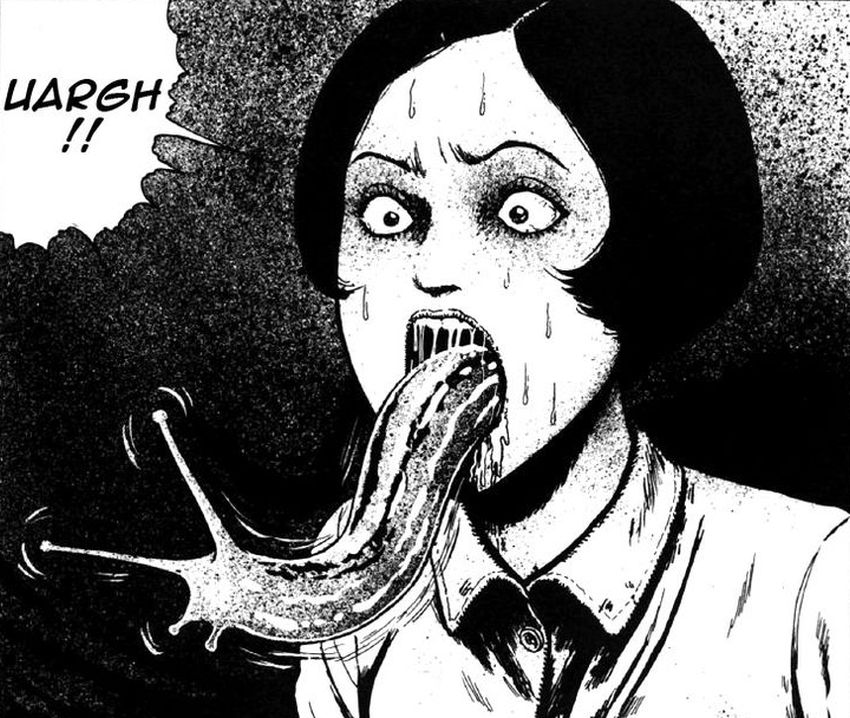
Slug Girl is a short but memorable piece of pure body horror. It’s one of Junji Ito’s most well-known stories, often appearing on horror manga lists.
Part of its appeal is how it delivers everything you expect from a classic Junji Ito story: bizarre imagery, creeping dread, a touch of disgust, and an unexpectedly sad ending.
Still, it’s over far too quickly, and I can’t help but wish the premise had been explored further.
The story follows Yuuko, who suddenly develops a painfully swollen tongue. At the same time, her family’s backyard becomes overrun with slugs, prompting her parents to eradicate them.
As Yuuko’s condition worsens, the disturbing truth about her illness is revealed.
It’s an absurd yet unsettling tale that taps into our fear of strange, inexplicable diseases, and is made even more disturbing by Ito’s grotesque artwork.
Where to read: Collected in Tombs.
39. Bronze Statue
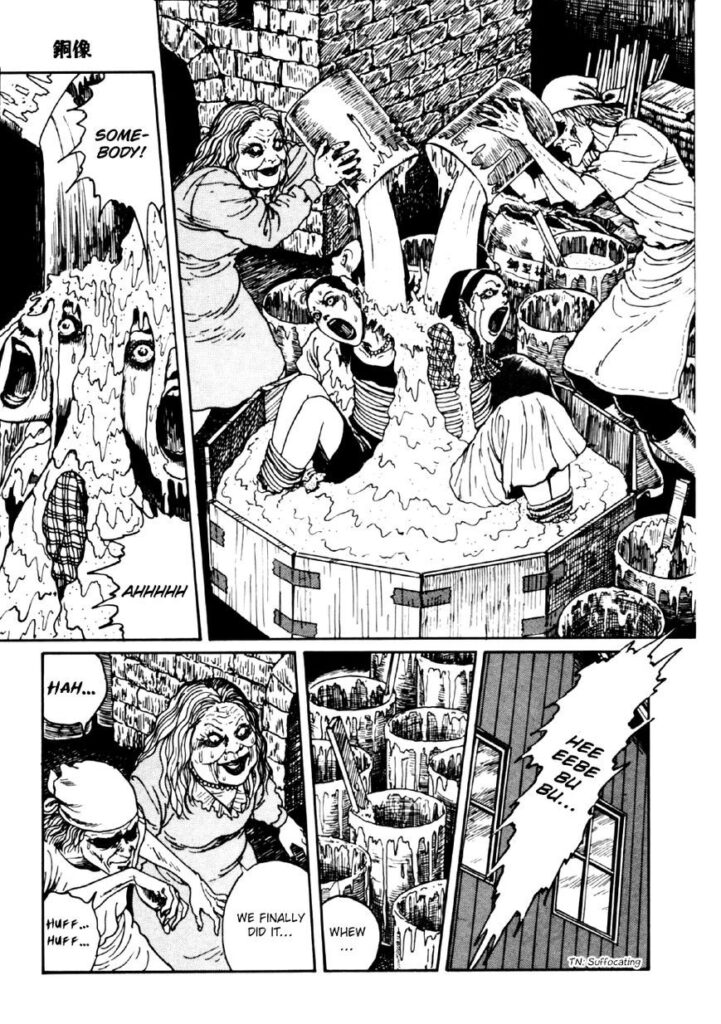
Bronze Statues is one of those Junji Ito stories where a single disturbing image can linger far longer than the plot itself. I first read it in raw Japanese, with no idea what was actually happening, yet the mental image stayed with me. We witness a group of women encased in plaster, their final, torturous moments immortalized in statue.
Compared to Ito’s more extreme work, this one isn’t the most grotesque or psychologically devastating, but the method of murder is chilling in its creativity. Once I finally read the translation and understood the story, I found it less impactful overall. The plot revolves around vanity, jealousy, and an obsession with beauty, all themes Ito has explored more effectively elsewhere.
While the narrative itself may not rank among his best, Bronze Statue is still worth reading for that unforgettable image of artistic cruelty.
Where to read: Collected in Tombs.
38. Drifting Spores
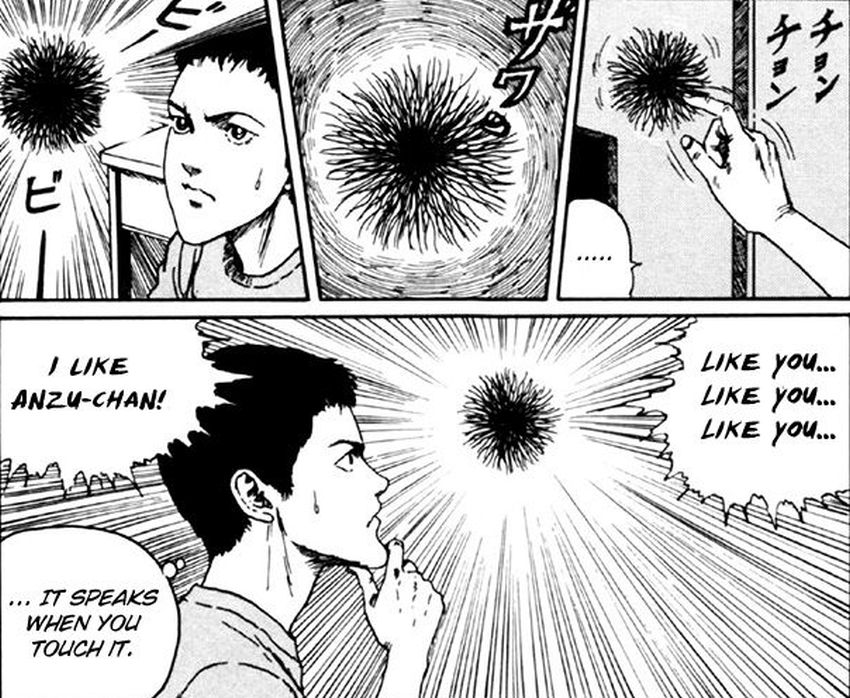
Drifting Spores is one of the quieter and more unusual Junji Ito stories you’ll encounter, and rarely mentioned in other lists. It’s not a typical horror piece filled with grotesque imagery, but rather a somber, thematically heavy tale.
In a small town, strange airborne spores appear that can mimic people’s voices and repeat what they’ve said. Locals begin collecting them, first out of curiosity, then to hear personal memories and secrets they were never meant to know.
The story explores themes of privacy, obsession, and the dangerous temptation of forbidden knowledge. One character’s fascination with the spores gradually escalates into obsession, culminating in a chilling act.
While it lacks the shock factor of Ito’s more infamous works, Drifting Spores is unsettling in a quieter way, and a reminder of how far human curiosity can push us when we tamper with things we don’t understand.
Where to read: Collected in Tombs, retitled Floaters.
37. Blood Sickness of the White Sands Village
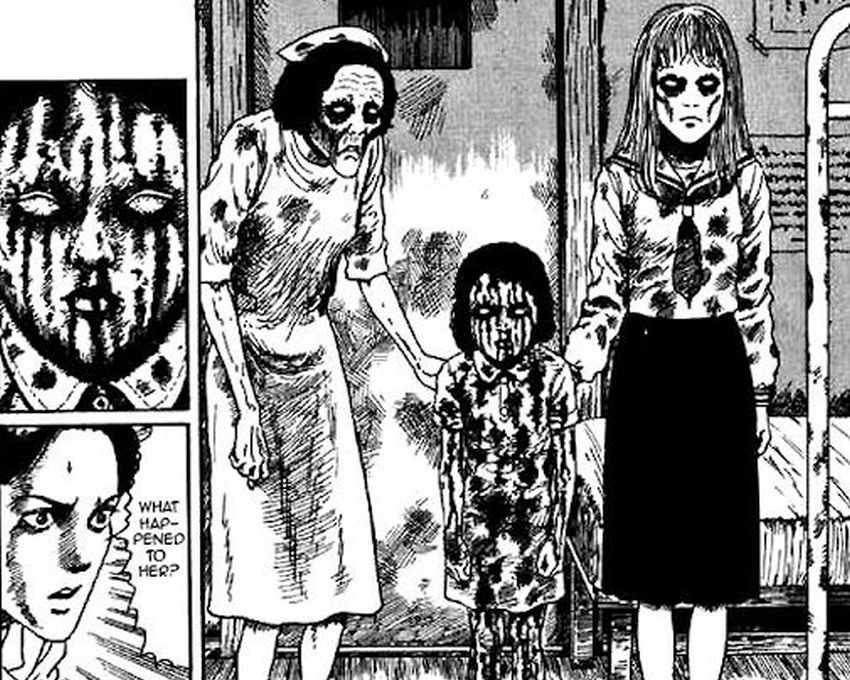
Blood Sickness of the White Sands Village is one of the most underrated Junji Ito stories. It’s a slow, atmospheric tale I almost never see mentioned.
It follows Furahata, a young doctor who moves to a remote, isolated village. The residents seem lifeless, gaunt, and perpetually unwell, plagued by a mysterious illness that causes sudden, profuse bleeding at irregular intervals.
As Furahata investigates, he unravels the disturbing truth behind both the sickness and the village itself. The pacing is deliberate, building an oppressive mood that feels almost Lovecraftian in its creeping inevitability.
I’ve always had a soft spot for this story, not just for its unsettling atmosphere, but because its final reveal reminds me of one in my own novel, New Haven. It’s a quiet gem in Ito’s catalogue.
Where to read: Collected in Tombs, retitled The Blood Story of Shirosuna.
36. Ice Cream Bus
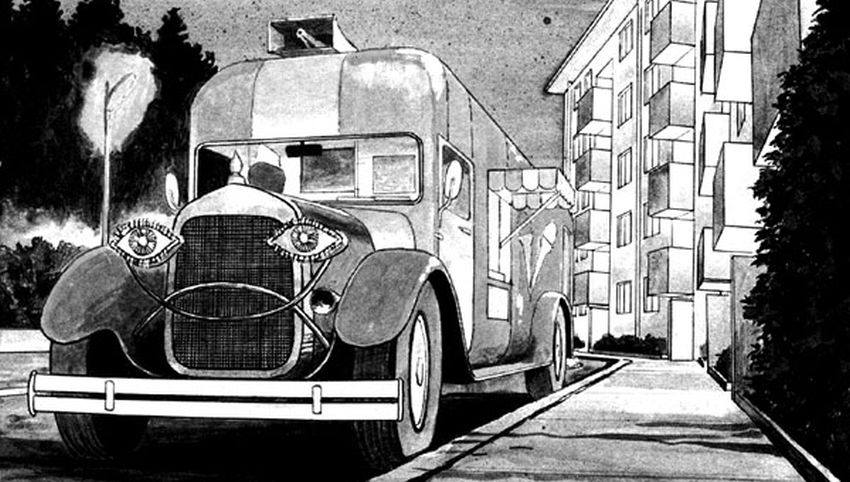
Ice Cream Bus starts with a premise that seems almost wholesome. The title alone evokes childhood nostalgia. For me, it brings back memories of the weekly ice cream truck during the hot summer, stocked with sweet treats.
But this is Junji Ito, so innocence never lasts.
In this story, an ice cream man visits the neighborhood each week, selling not only frozen treats but also offering the kids a ride in his truck. The narrator, a recently divorced father, eventually allows his son to join.
Over time, he notices something strange. Everything in his home, the neighborhood kids and even his own son feels sticky. The unease builds until the truth is revealed in a memorably grotesque finale.
While the concept borders on the absurd, it’s a great example of Junji Ito’s ability to twist something mundane and comforting into something deeply unsettling. It’s not his strongest story, but it’s undeniably memorable for how it turns a sweet childhood memory into pure horror.
Where to read: Collected in Alley.
35. Mold
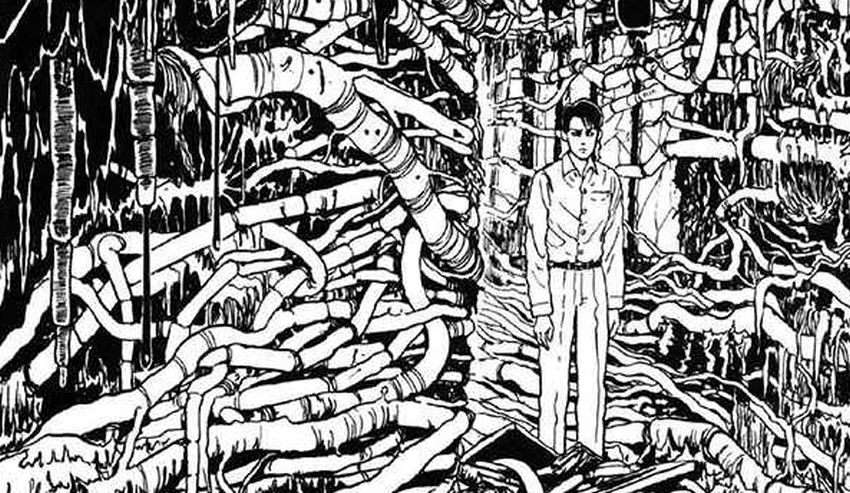
Mold is one of the most revolting Junji Ito stories ever, and with a title like that, it’s easy to see why.
A young man returns home after a year abroad to find his subtenants have vanished, leaving the place in a state of filth and abandonment. Even worse, mold has crept across the walls, floors, and ceilings. The previous tenant, his former teacher Mr. Rogi, had an unusual passion for studying fungi.
The narrator’s attempts to clean the house are futile. Whatever he does, the mold grows back faster and thicker, slowly transforming the entire building into a festering, pulsing nightmare. Black liquid oozes from strange tubular growths, and the air feels heavy with rot.
As the infestation worsens, the narrator eventually learns the horrifying fate of not only Mr. Rogi but his entire family, a fate he might soon share.
With its claustrophobic setting and stomach-turning imagery, Mold is a germophobe’s worst nightmare, brought to life by Ito’s unmatched ability to make decay feel almost tangible.
Where to read: Collected in Alley.
34. The Village of Ether

Village of Ether is one of the most intriguing modern Junji Ito stories, collected in The Liminal Zone Vol. 2.
Yota and three of his university friends return to his hometown of Towano, only to find it eerily abandoned. Two enormous slag heaps, which weren’t there before, loom over the outskirts. As they explore, they stumble upon something even stranger: a perpetual motion machine, quietly and impossibly running.
Yota insists such machines are real, recalling how a local man named Haruto, a childhood friend, devoted his life to perfecting his father’s designs. The group soon finds more of these devices scattered throughout the village, their silent movements defying the laws of physics. But what begins as a curious mystery soon twists into something far darker, when the truth about Haruto’s work and the state of the town finally come to light.
Village of Ether starts with a concept so ambitious it feels like classic science fiction, then spirals into chaos in true Ito fashion. While its ending and final reveal aren’t the most satisfying, the premise and build-up make it stand out as one of his most memorable recent works.
Where to read: Collected in The Liminal Zone Vol. 2.
33. Ribs Woman
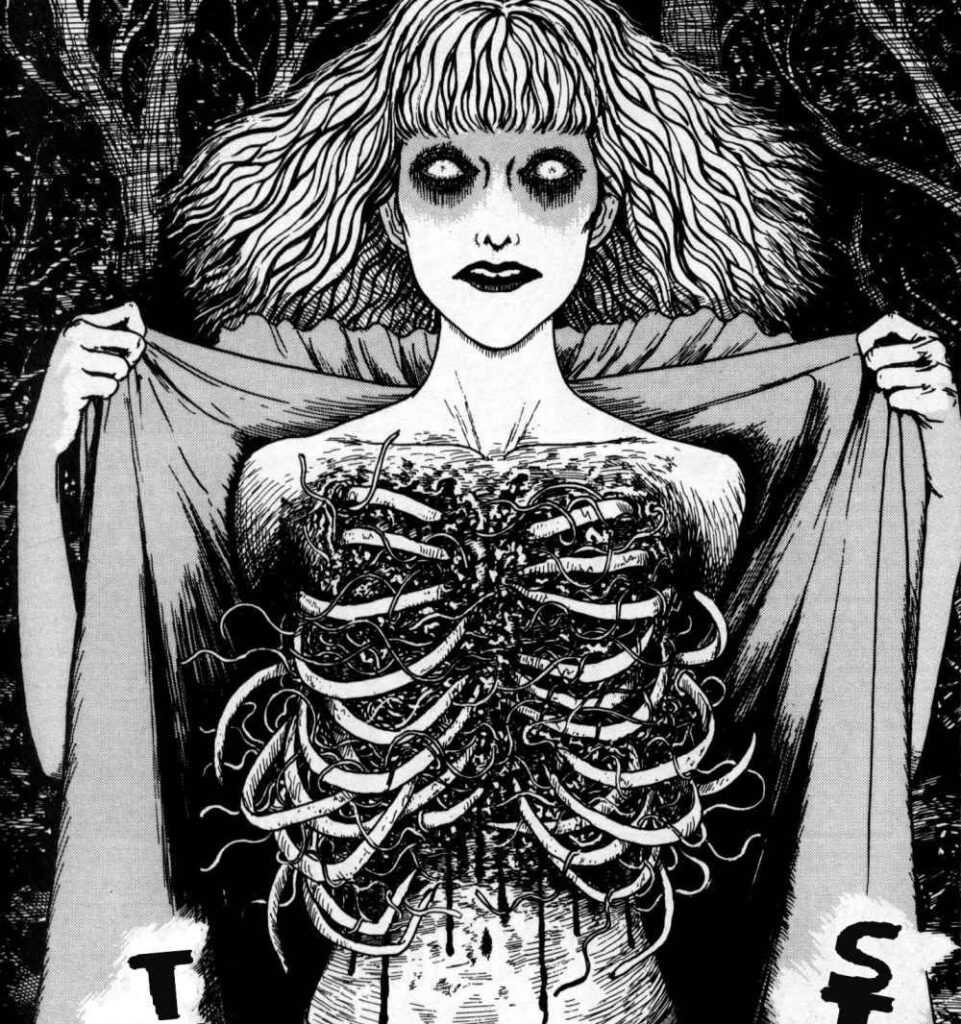
Ribs Woman is one of the most surreal and unsettling Junji Ito stories, exploring themes of plastic surgery and body image. Yet the premise feels unusual given that both main characters, Yuki and Ruriko, are still in high school.
Yuki longs to be beautiful, and her obsession eventually drives her to undergo an extreme procedure, removing several ribs to achieve a slimmer waist. Her friend Ruriko has undergone the same surgery, but soon begins to hear eerie, haunting music that no one else seems to notice. The source turns out to be a strange, menacing woman playing a grotesque harp made from bone.
From here, the tale unravels into pure nightmare fuel as the truth behind the instrument, and the woman who wields it, comes to light. The final revelation features one of Junji Ito’s most infamous body horror visuals, an image that has since gained widespread recognition.
While the setup involving high schoolers and extreme cosmetic surgery feels odd and somewhat disjointed, the haunting imagery and bizarre final concept make Ribs Woman a standout in Ito’s catalogue. Part of its grotesque creativity even inspired my story, Real Art Always Has a Price.
Where to read: Collected in Lovesickness, retitled The Rib Woman.
32. Unbearable Maze
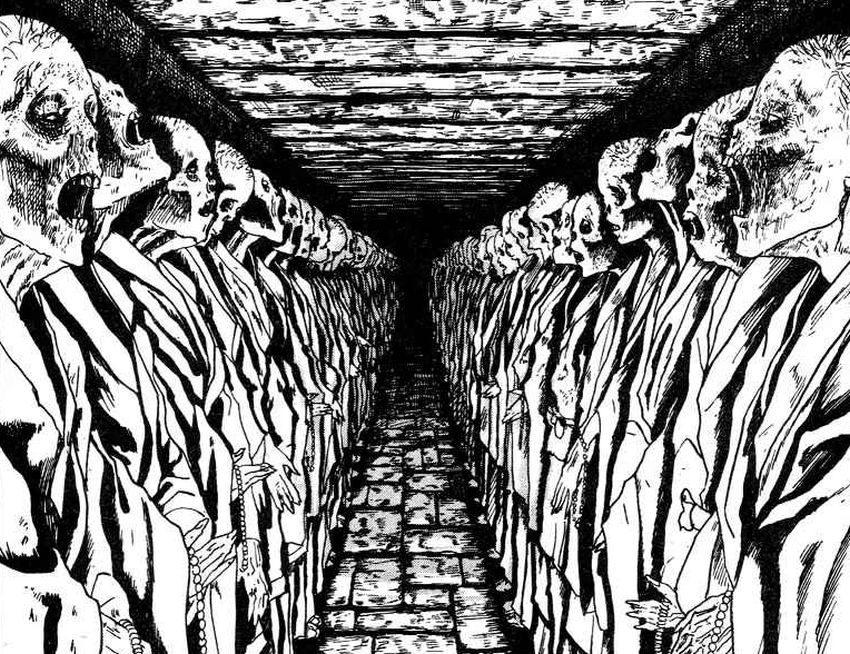
Unbearable Maze follows Sayoko, a young woman who joins her friend on a hiking trip. Her friend is concerned because Sayoko hasn’t been to school in some time and won’t explain why. When the two become lost in the mountains, they stumble upon a remote monastery.
On a whim, Sayoko decides to stay and join the monastery’s healing meditation program, drawn in by the promise of peace. From another visitor, they learn the truth: the monks’ eternal meditation ends in their becoming Buddhist mummies.
Eventually, Sayoko and her friend wander into the labyrinth where the preserved monks rest. Deep inside, they discover something far worse: a section where the monks are still alive, their eyes now staring straight at them. Here, under the gaze of hundreds of unblinking eyes, Sayoko finally admits her secret: she suffers from an intense fear of being watched.
While the setup is fairly simple, Ito turns it into a deeply personal nightmare. The final image of Sayoko trapped in a never-ending corridor of staring monks is unforgettable, and the perfect embodiment of her private hell.
Where to read: Collected in Deserter, retitled Unendurable Labyrinth.
31. Mimi’s Tales of Terror
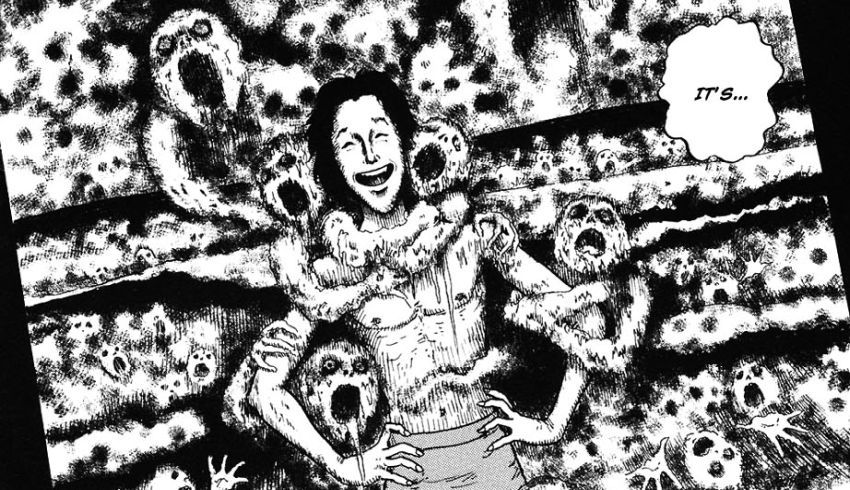
Mimi’s Tales of Terror is a collection of six ghostly encounters experienced by a young woman named Mimi. What makes this volume unique is that Junji Ito didn’t write these stories; instead, he adapted well-known Japanese urban legends into manga form.
The result blends classic folktale eeriness with Ito’s signature art style. While the illustrations carry his trademark unsettling atmosphere, the narratives themselves feel noticeably different from his usual work. They’re simple, more in line with traditional ghost stories than Ito’s surreal or grotesque horror.
Of the six, The Seashore is my favorite because it contains the most stunning piece of visual horror in the entire collection, even if it doesn’t quite reach the same intensity as other Junji Ito stories.
Still, Mimi’s Tales of Terror offers a fascinating glimpse at how urban legends can be reimagined through Ito’s pen. It’s a worthwhile read, especially for fans of Japanese folklore.
Where to read: Mimi’s Tales of Terror (single-volume edition).
30. The Insects of Bishakeura
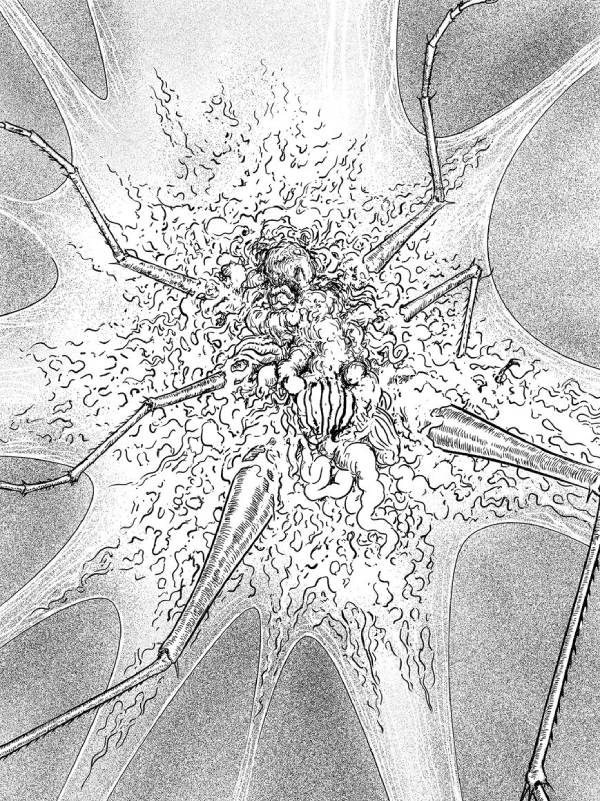
The Insects of Bishakeura is a standout tale from Sensor, Junji Ito’s collection that leans into philosophical horror and showcases some of his most striking artwork. While Sensor as a whole never fully clicked for me, this particular story still lingers in my mind.
The main character, Byakuya Kyouko, arrives in a small coastal village overrun by strange, fleshy insects known as suicide bugs. One nearby cliff is a famous suicide spot, and it soon becomes clear that the two are connected. Invited to stay in the village, Byakuya eventually learns the grim truth.
It’s a short, straightforward narrative, but its strength lies in the repulsive, visceral imagery. The bugs themselves, including the squishy, oozing remains they leave behind, are rendered in nauseating detail, pushing Ito’s mastery of body horror to the forefront.
In a collection full of grand, abstract Junji Ito stories, The Insects of Bishakeura is refreshingly direct and revoltingly memorable.
Where to read: Collected in Sensor.
29. Hellstar Remina
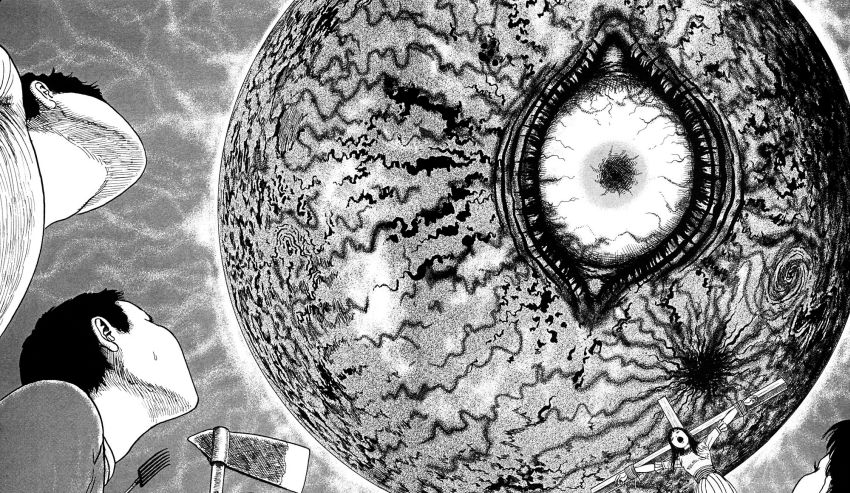
Hellstar Remina is one of Junji Ito’s most striking examples of Lovecraftian cosmic horror because it leans fully into planetary-scale doom.
The story begins when Professor Oguro discovers a wormhole, and beyond it a strange new planet. When he names it after his daughter, Remina, the young woman turns into a celebrity overnight. Yet the planet’s movements defy all orbital logic, zigzagging through space as nearby stars mysteriously vanish.
Soon, the truth becomes horrifyingly clear: the planet is alive, and it is heading straight for Earth. As it enters our solar system, it devours the planets one by one, drawing ever closer. From here, the story spirals into chaos. Humanity’s reaction becomes as dangerous as the threat itself, as the mob turns on the professor and his daughter in a frenzy of fear and paranoia.
Visually, Hellstar Remina is spectacular. The planet with its gaping eyes and maw is nothing short of unforgettable. Even worse is its twisted surface, which is the stuff of nightmares.
As the plot continues, however, it grows increasingly frantic and absurd, causing some of the tension to slip away.
Even so, the premise is brilliantly unique, and while the execution may stumble here and there, the sheer creativity and imagery make this one of the best Junji Ito stories of all time and a must-read for fans of cosmic horror.
Where to read: Hellstar Remina (Deluxe Edition).
28. Flesh-Colored Horror
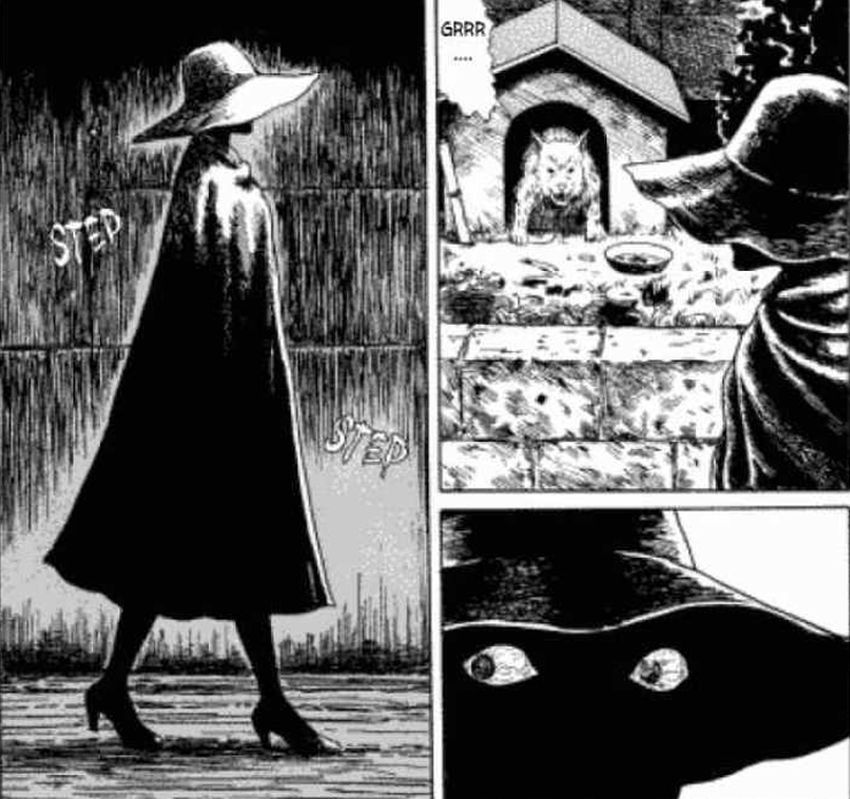
Flesh-Colored Horror begins with Miss Takigawa, a kindergarten teacher, walking home late at night when she is suddenly attacked by an unknown assailant and doused in a strange liquid.
Back at the kindergarten, she’s already dealing with trouble from Chikara, a violent, disruptive child who lashes out at his classmates. Concerned, Miss Takigawa visits his home to speak with his parents, only to uncover the horrific truth behind his behaviour, as well as the nature of the liquid she encountered.
This is one of the first Junji Ito stories I ever read, and it left a strong impression. The concept is bizarre, grotesque, and entirely original. It’s the type of imaginative body horror Ito excels at. While not as well-known as his other works, Flesh-Colored Horror is a memorable showcase of just how strange and inventive his horror can be.
27. Den of the Sleep Demon
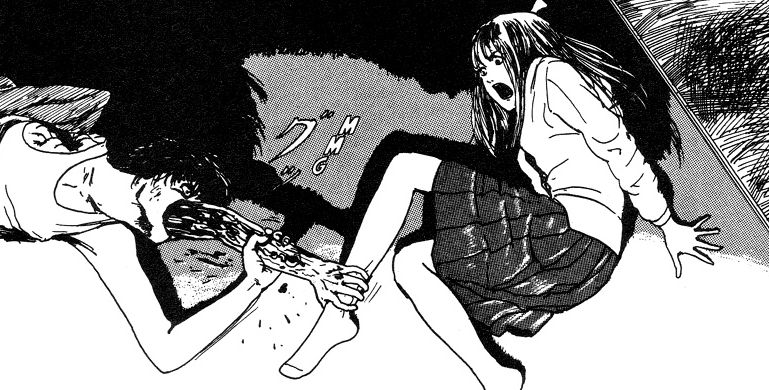
Den of the Sleep Demon is one of the shorter Junji Ito stories on this list, but it’s a fantastic read that blends paranoia, surreal horror, and impossible odds.
Yuji, a young writer, confesses to his girlfriend Mari that he hasn’t slept in three days. It’s not because of insomnia, but because he’s terrified of his own dream-self. According to Yuji, this other self wants to replace him in the waking world, and emerges every time he falls asleep.
Mari dismisses the idea at first, but agrees to help him rest. Soon, however, she realizes Yuji’s fears aren’t as irrational as they sound, and that he’s trapped in a battle he can never win. After all, no one can stay awake forever.
It’s a simple premise, but Ito elevates it with unsettling imagery and the creeping inevitability of Yuji’s fate. The result is a tight, chilling piece of nightmare logic.
Where to read: Collected in Deserter, retitled Where the Sandman Lives.
26. Gyo
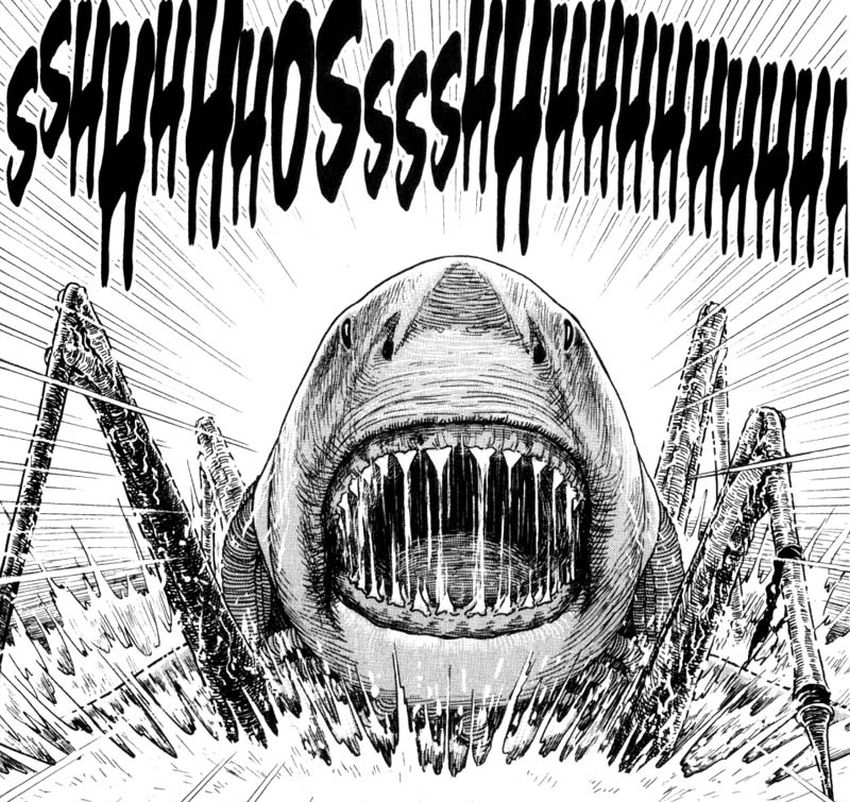
Something stinks.
Gyo is one of Junji Ito’s most iconic and absurd works. The premise is deceptively simple: sea creatures emerge from the depths and invade the land on spindly, insect-like mechanical legs.
The story begins with Tadashi and his girlfriend Kaori on vacation. Kaori, sensitive to smells, soon notices a foul, rotten stench. The source is a strange fish skittering through their home on metal legs, leaving the stench in its wake. At first, it’s a single small fish. Soon, larger ones appear, and eventually even a giant shark.
Back in Tokyo, the death stench spreads, and millions of sea creatures flood Japan in an apocalyptic tide. Ito cleverly combines two primal fears: the unknown horrors of the deep sea and the unsettling, frantic movements of insects. To all this, he adds the sensory assault of a nauseating, inescapable smell.
While Gyo is brimming with creativity and unforgettable imagery, it suffers when Ito attempts to explain the phenomenon. The mystery begins as absurd, shifts to ridiculous, and ends in outright silliness. Horror often thrives when left unexplained, and here, the attempt at logic weakens the horror.
Still, the visuals are phenomenal, especially in later chapters, when it’s not just fish but bloated, disfigured humans marching on metal legs. A standout moment to me was the infamous circus chapter, which arrives out of nowhere and delivers one of Ito’s most stunning single pages.
Despite its flaws, Gyo remains a unique, memorable work. It’s a bizarre, grotesque spectacle and clearly one of the best Junji Ito stories.
Where to read: Gyo (Deluxe Edition).
25. The Chill
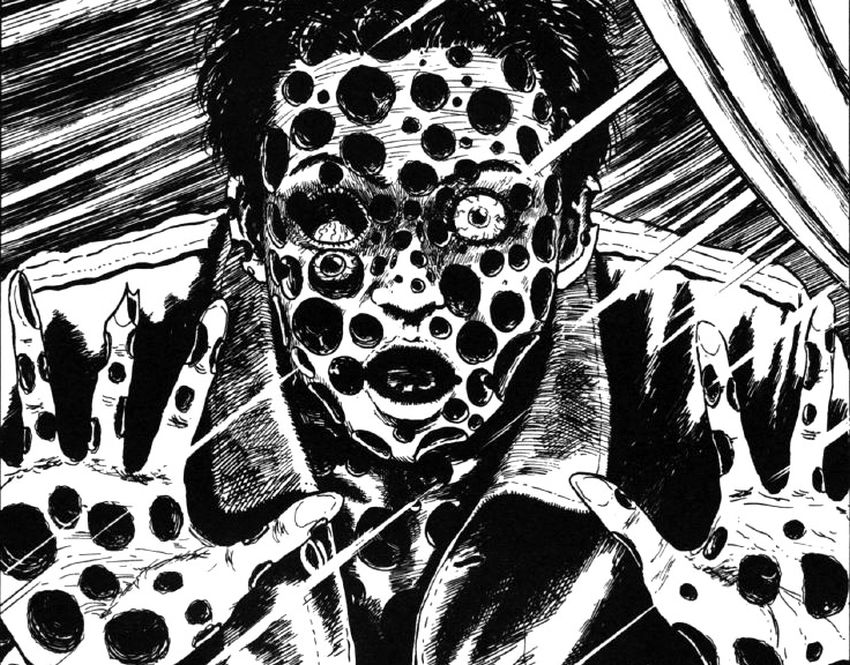
Considering Junji Ito’s interest in phobias, it was inevitable that he’d tackle trypophobia. The Chill is the result, and it’s a fantastic story. There’s something about holes appearing across the human body that is both deeply unsettling and strangely fascinating.
The story begins with Yuuji, who talks about his neighbor Rina, a girl who rarely leaves her home because of a strange illness. Holes appear all over her arm, and when Yuuji sees them, he remembers his grandfather once suffered from the same condition, and eventually died from it.
Disturbed, Yuuji confides in his best friend Hideo, and together they investigate. Their search leads them to a strange jade statue that seems tied to the disease.
Like many other Junji Ito stories, The Chill is a tale about humans meddling with forces they don’t understand, driven by greed and obsession. And at its core, it’s a story about holes, lots and lots of holes.
Where to read: Collected in Shiver, retitled The Chill.
24. The Human Chair
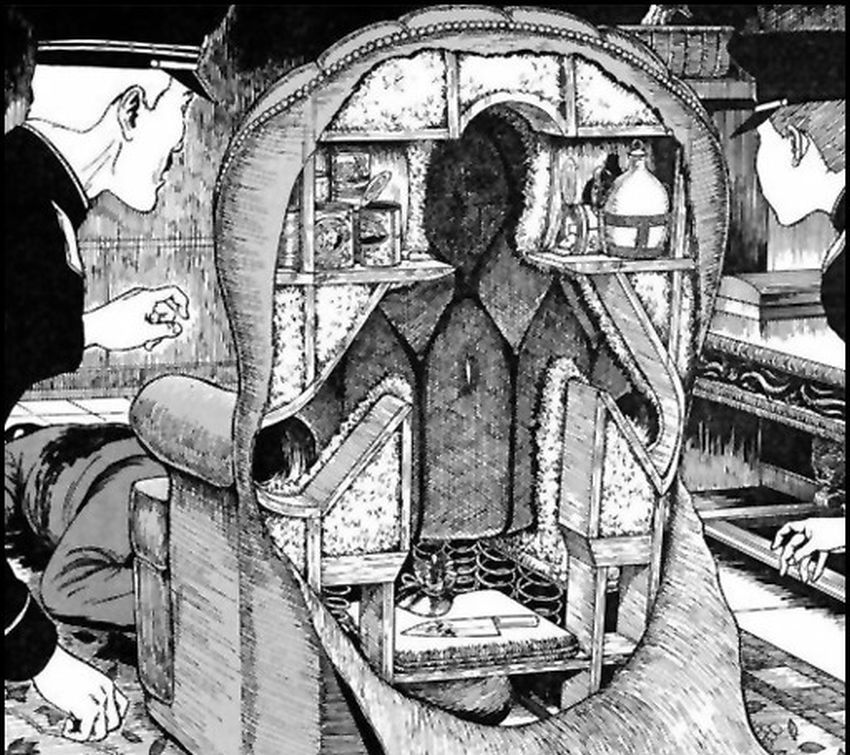
The Human Chair is originally a story by Japanese writer Edogawa Ranpo, later adapted into manga form by Junji Ito.
It follows a female writer bearing the same name as the original author, who receives a letter from a fan. Inside is a deeply unsettling manuscript about someone secretly hiding and living in her armchair.
This is one of Ito’s most frequently mentioned works, and for a good reason. The premise alone is disturbing, touching on themes of privacy, obsession, and the violation of personal space.
What makes this adaptation so effective is Ito’s signature art style, which lends an extra layer of discomfort to an already unnerving concept. It’s a simple setup, but one that lingers in the mind longer after you’ve finished reading.
Where to read: Collected in Venus in the Blind Spot.
23. Dissection Girl
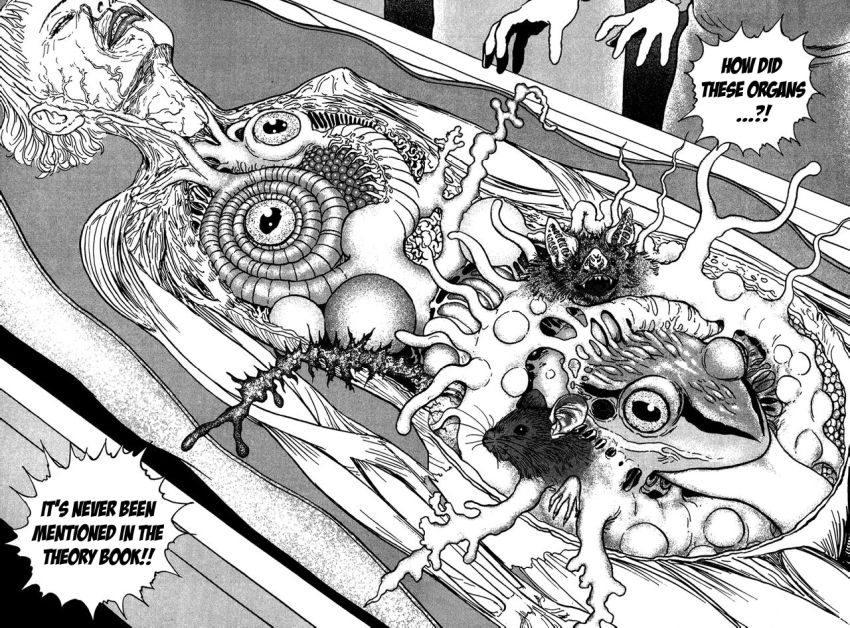
Dissection Girl is a prime example of Junji Ito’s mastery of body horror and his incredible artistic skill.
At its core, it’s a story about body dysmorphia, but in true Ito fashion, it takes the concept to disturbing extremes. This isn’t about altering one’s appearance; it’s about the obsessive desire to be cut open and dissected.
Ruriko, a young doctor, is approached by a mysterious woman who requests just that. As the story unfolds, we learn more about her and the disturbing reason behind her fixation.
This tale combines two of Ito’s most prominent themes: grotesque bodily transformation and psychological instability. What truly makes it memorable is the final page, which delivers one of the most absurd yet unforgettable depictions of body horror.
Where to read: Collected in Fragments of Horror, retitled Dissection-Chan.
22. The Secret of the Haunted Mansion
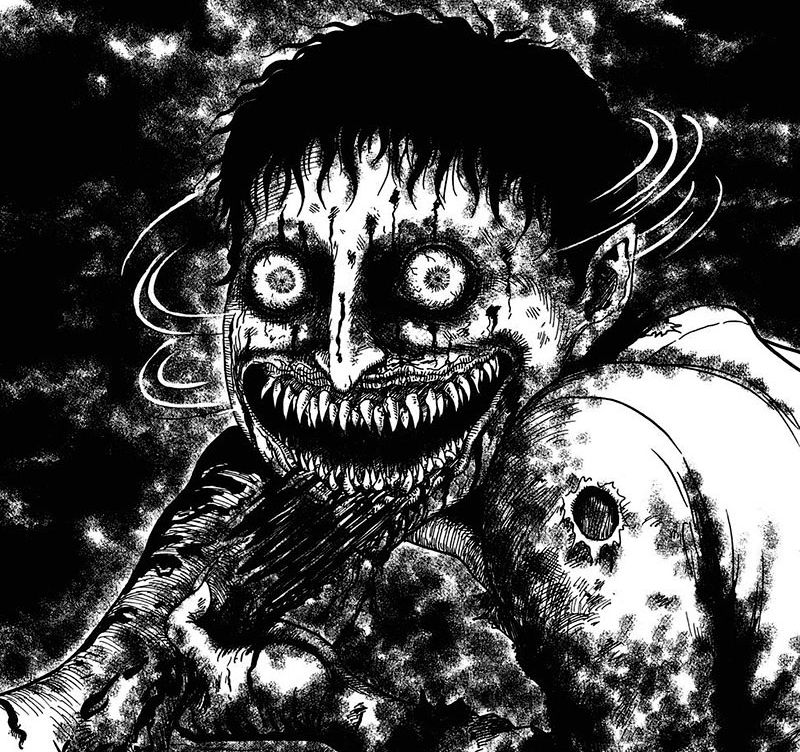
As the title suggests, The Secret of the Haunted Mansion centers on a haunted attraction, but the word haunted might put it lightly.
The story follows two young boys who hear about a mysterious new haunted house in town. They watch a visitor enter, only to flee moments later, pale and terrified. Curiosity gets the better of them, and when the eccentric owner offers them free admission, they instantly accept.
What follows is a series of bizarre and unsettling surprises, both for the boys and the reader, especially since some of Ito’s recurring characters make an appearance.
The Secret of the Haunted Mansion is one of the most memorable Junji Ito stories, not just for its strange twists, but for one of Ito’s most unsettling illustrations, a single image that will linger in your mind long after you finish reading.
Where to read: Collected in Smashed, retitled The Mystery of the Haunted House.
21. The Thing That Drifted Ashore
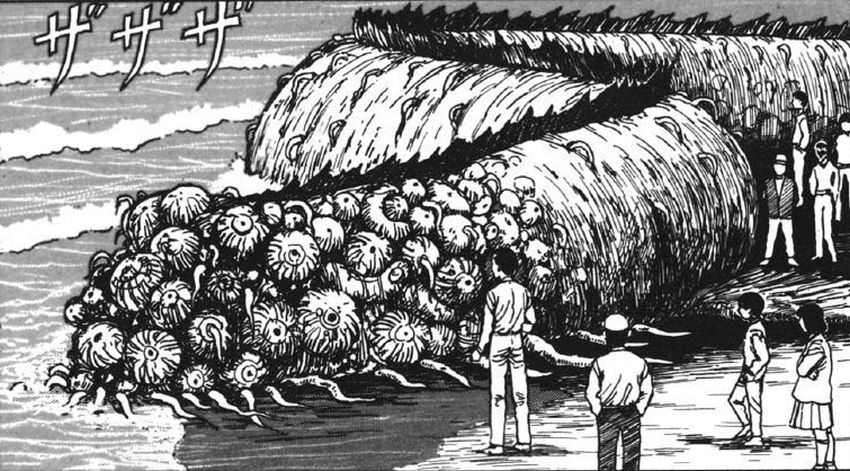
The deep sea is one of the few places on Earth that remain largely unknown.
Unlike the vastness of space, which feels distant, the ocean is right here, bordering our coasts. And yet, we’ve explored so little of it. That uncertainty sparks the imagination, and the thought of what might lurk in its depths can be deeply unsettling.
The premise is simple but chilling: a massive, grotesque deep-sea creature washes ashore. It’s not a whale, nor anything recognizable. Instead, it’s an unidentifiable, almost Lovecraftian horror.
Crowds gather, some driven by morbid curiosity, others hoping to identify the bizarre specimen. As the story unfolds, an even more horrifying revelation emerges: something is moving inside the creature’s body, something that’s very much alive.
While many Junji Ito stories deal with the unknown, what makes this one so memorable is the sense that it isn’t entirely implausible. In the unfathomable dark of the ocean, who’s to say there aren’t real creatures as strange and terrible as the one Ito imagines?
Where to read: Collected in Tombs, retitled Washed Ashore.
20. The Window Next Door
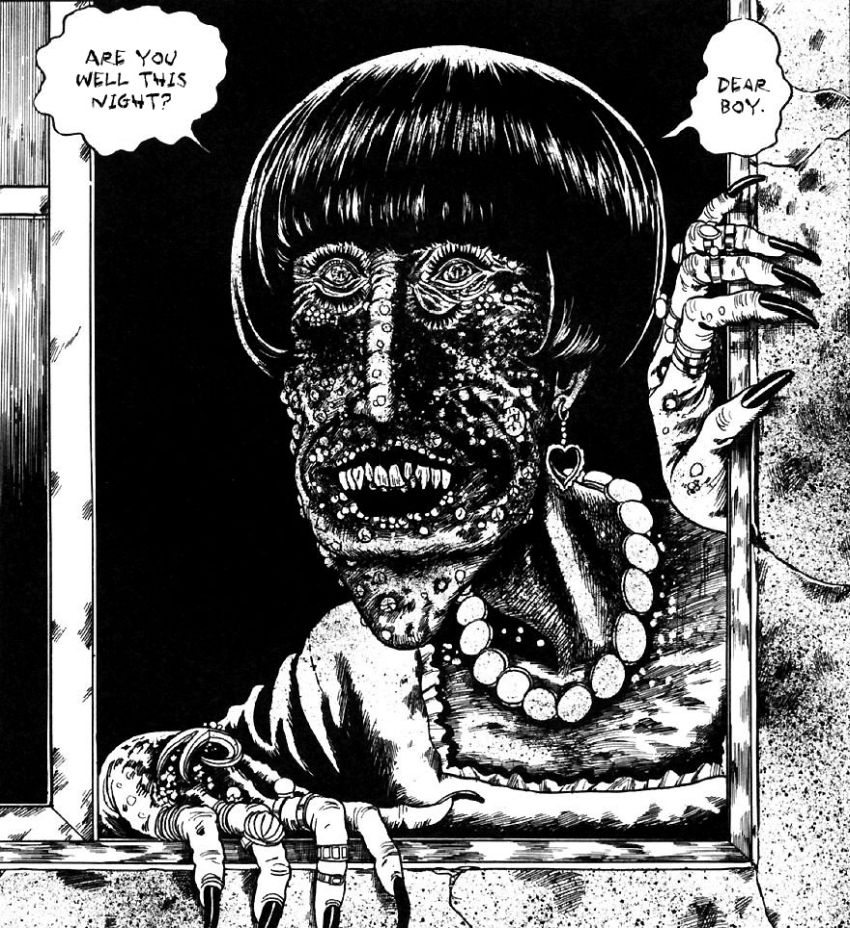
This is another of the most popular Junji Ito stories.
The premise is simple. Hiroshi and his family move into a new home, which sits right next to a strange, almost entirely windowless building. There’s only one window, and it faces directly into Hiroshi’s room.
They soon learn that the building is home to a reclusive woman. But when Hiroshi finally sees her, Ito delivers one of his most iconic and unsettling illustrations.
It’s the detail, the atmosphere, and the sheer artistic skill in this single image that elevate the story. The rest is almost forgettable, even anticlimactic.
Still, I hold The Window Next Door in high regard, not only for its visual impact but because it inspired my own story, The Disappearing Alley.
Where to read: Collected in Tombs.
19. Black Paradox
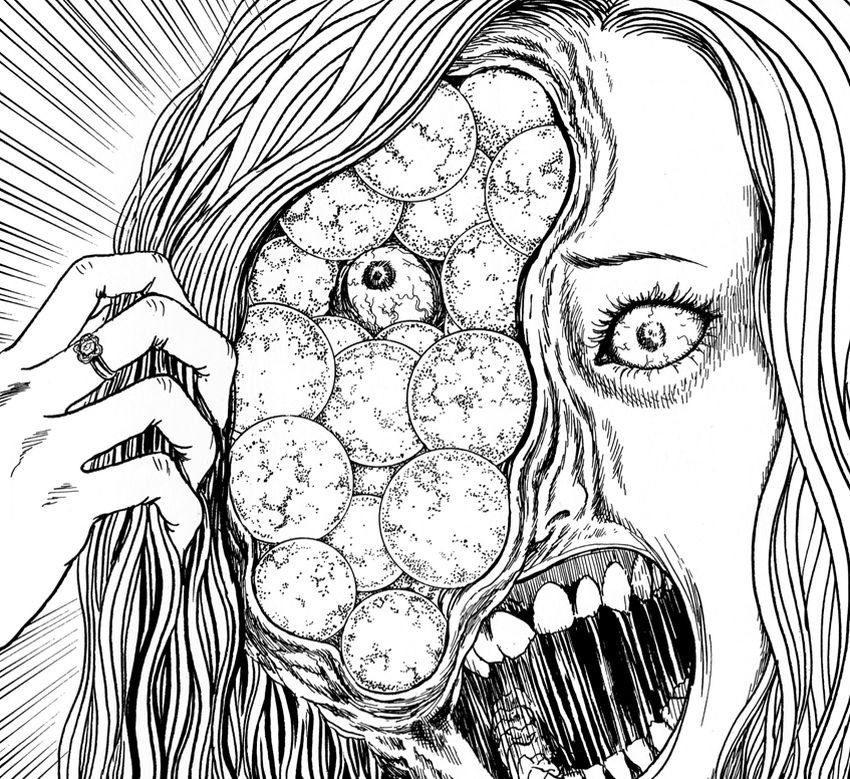
Black Paradox is wild, weird, and surprisingly compelling.
It begins with four strangers who form a suicide pact, agreeing to end their lives together. Somehow, our main character Marusou ends up with a group of doppelgangers instead.
After uncovering the truth and reuniting with the real group, they delay their plan and agree to meet again to go through with it. From there, the story only grows stranger, more philosophical and existential.
One of Junji Ito’s longer works, Black Paradox runs for six chapters. Its biggest flaw is the disjointed opening. It begins with a suicide pact, but the series quickly shifts focus to something entirely different.
Still, Ito’s signature artwork and wild imagination are on full display. As strange as the beginning is, the story improves as it continues, and its surreal twists make for an unforgettable ride.
Overall, Black Paradox is an enjoyable read, and one of the most unique Junji Ito stories on this list.
Where to read: Black Paradox (single-volume edition).
18. Glyceride
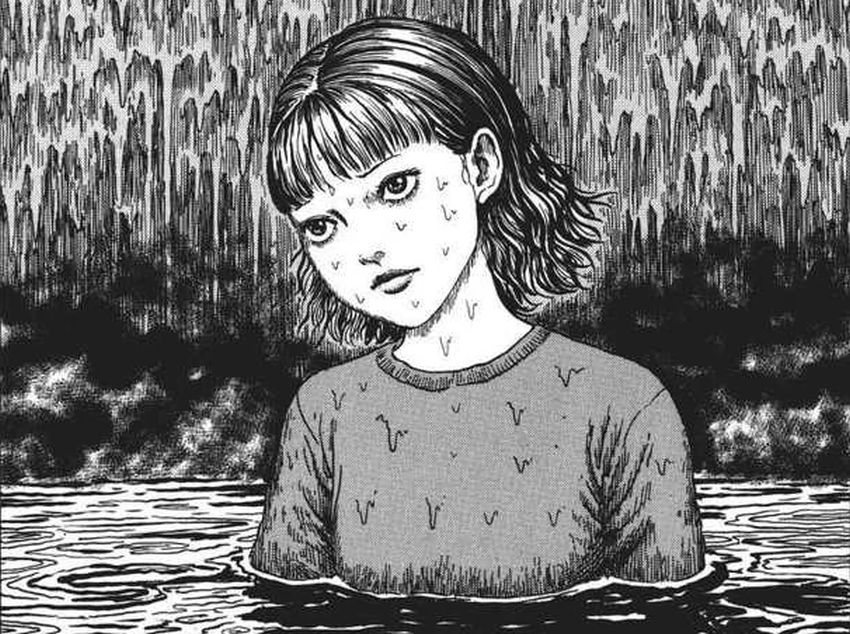
Many Junji Ito stories feature disturbing imagery, but Glyceride might be the most stomach-churning of them all.
It follows Yui, a young girl living with her sadistic older brother and father above the family’s yakiniku restaurant. The constant cooking has coated the entire house in a thick layer of grease.
Her abusive brother soon hits puberty and develops acne. Thanks to the suffocatingly greasy air, and his unsettling habit of drinking oil, his pimples become far worse than normal. You can probably guess where this is going.
But the horror doesn’t end with a single grotesque eruption. There’s something even more sinister lurking behind the walls of the family restaurant.
Interestingly, Ito said the story was partly inspired by his time in dental school, when he was forced to sleep on a dirty, sweat-soaked futon.
Glyceride is easily one of Ito’s most revolting tales, and it delivers another of his most infamous illustrations. Read it, but consider yourself warned.
Where to read: Collected in Shiver, retitled Greased.
17. Town Without Streets
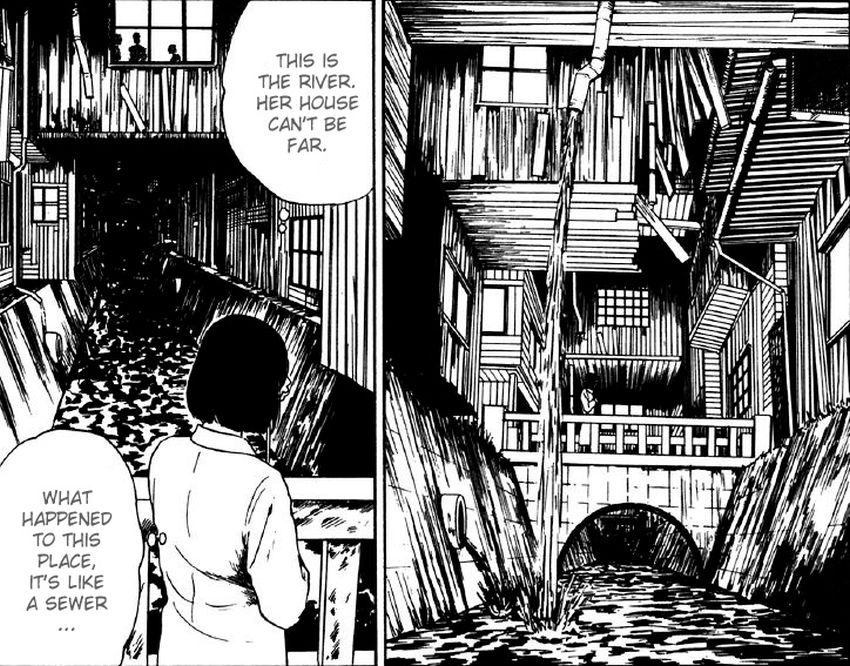
I’ve always been a fan of concepts like a city contained entirely within a building, which is why I love stories set in confined and restricted spaces.
This story follows Saiko, who’s sick of her family constantly spying on her. She decides to leave and stay with her aunt instead.
When Saiko arrives, she discovers something strange: all the streets have been blocked off by ramshackle wooden structures. In fact, the entire town has been boarded up to the point that it feels like a single, massive building.
With no open roads, residents are forced to travel by passing through one another’s homes. Privacy has been completely erased, and an unsettling sense of being watched hangs over the town.
There’s also a secondary plot involving a killer who appears in people’s dreams. While it feels somewhat disconnected from the main storyline, it could be read as another metaphor for intrusion. Not even your dreams belong to you.
The real strength of this story is its bizarre, claustrophobic setting and Saiko’s journey through the interconnected homes. It’s a perfect example of Ito blending surreal concepts with deeper, more serious themes like the erosion of privacy. Definitely one of my favorite Junji Ito stories.
Where to read: Collected in Alley, retitled Town of No Roads.
16. The Bully
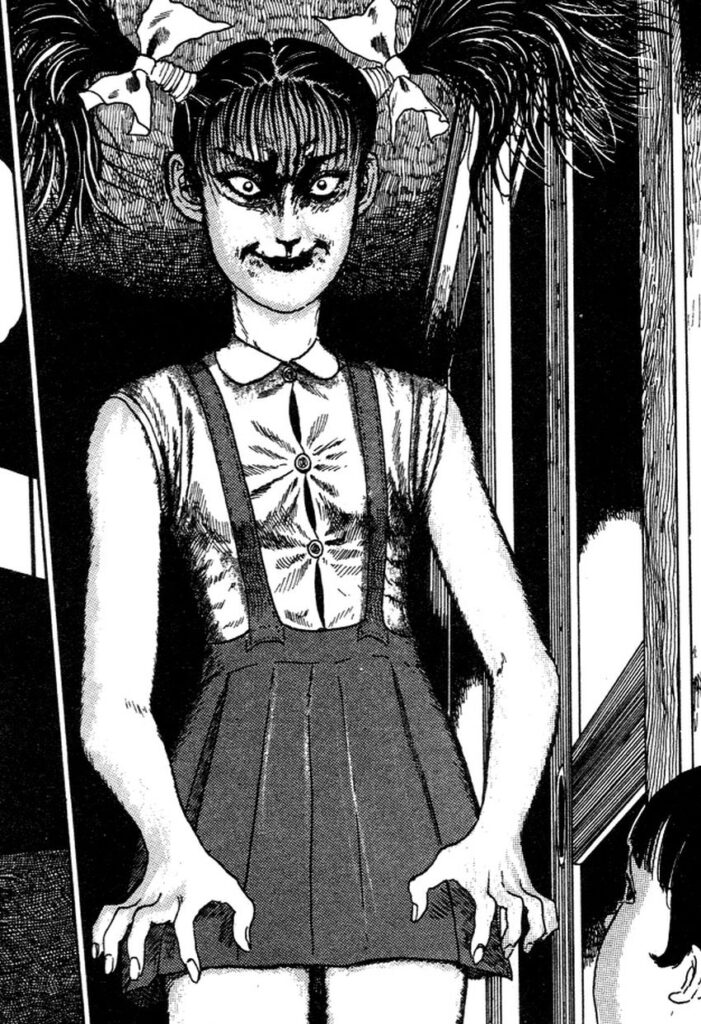
Oh, The Bully, what a story.
Junji Ito’s works are rarely grounded in reality. They almost always feature monsters, bizarre powers, or supernatural entities. This one is a rare exception.
It’s a simple tale about a young girl who bullies a little boy. Years later, the two meet again as adults, and at first it seems things might take a turn for the better.
But this is a Junji Ito story, so there’s no happy ending to be found.
What makes The Bully so disturbing is not only the complete absence of the supernatural but also its plausibility. Everything in it is painfully real, and that makes the horror hit even harder.
Where to read: Collected in Deserter, retitled Bullied.
15. The Licking Woman
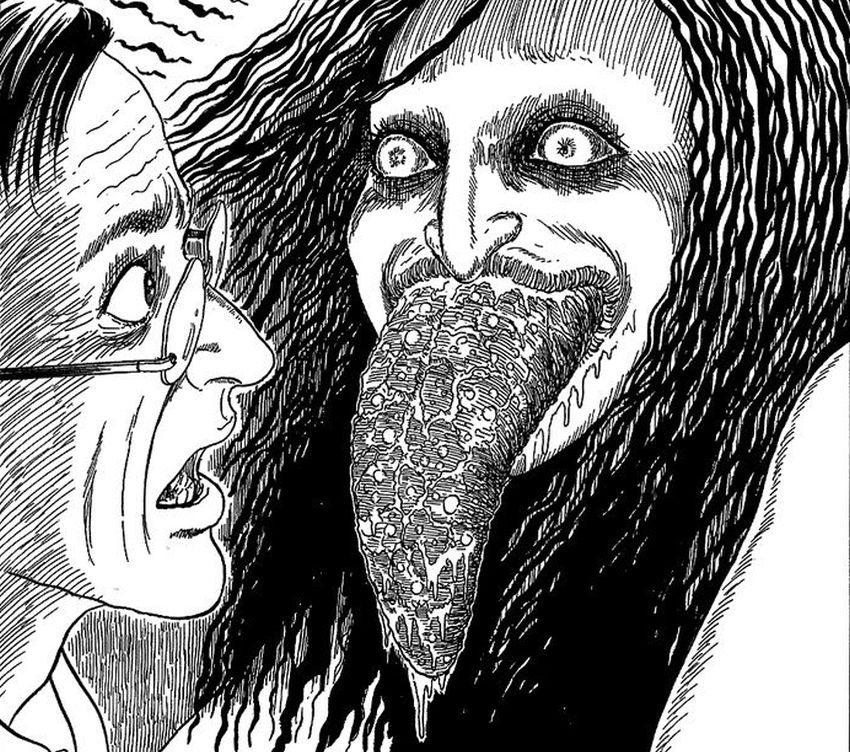
Imagine a stranger running up to you and licking your face. That’s the unsettling premise of this Junji Ito story.
Miku’s fiancé Tsuyoshi gets licked by a mysterious woman on the way home. But this isn’t just about the disgust of unwanted contact. The Licking Woman’s saliva turns out to be deadly, and soon after Tsuyoshi dies from it.
As time passes, more attacks are reported, and more people are injured or killed. Driven by grief and anger, Miku vows revenge and sets out to kill the Licking Woman. But her path comes to a surprisingly grim and absurd conclusion.
The Licking Woman is one of the rare Junji Ito stories that delivers on multiple levels. The revulsion of the act itself, the horror of its consequences, and most of all, Ito’s unforgettable imagery. The bloated, glistening tongue, the warped mouth, and the wild eyes turn the Licking Woman into something grotesque and barely human.
Overall, it’s a grotesque and memorable tale, and one I enjoyed a lot.
Where to read: Collected in Venus in the Blind Spot.
14. Frankenstein
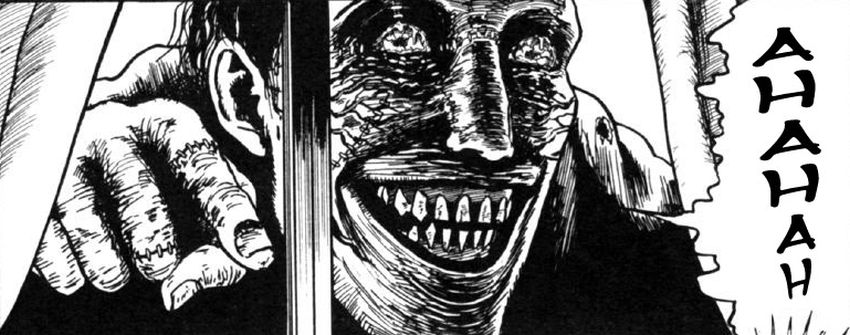
Most people are familiar with the story of Frankenstein, or have at least heard of it. Having read the original novel and seen several movie adaptations, I can say Junji Ito’s take is absolutely phenomenal and perhaps the best adaptation of Mary Shelley’s work to date.
Ito’s strange, unsettling imagery doesn’t just translate Shelley’s work to a different medium, it enhances it. His atmosphere and visual style lend themselves perfectly to Shelley’s gothic horror story. When the horror hits, Ito’s exaggerated expressions and grotesque body horror transform the story into a visual nightmare.
This volume is nothing short of a masterpiece. I highly recommend it to anyone who’s a fan of either the original novel or Junji Ito stories.
Where to read: Frankenstein (single-volume-edition).
13. Tomie
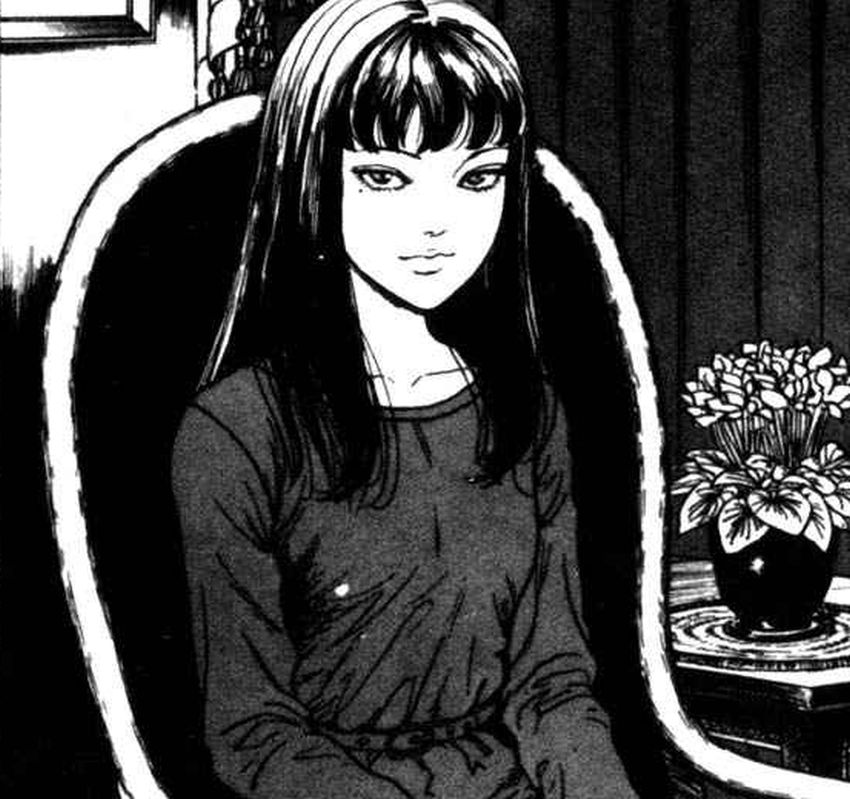
Tomie is another one of Junji Ito’s recurring characters and probably his most popular character. Her stories span three volumes and spawned an entire series of live-action movies.
It’s even more interesting when you consider that Tomie was one of Junji Ito’s earliest works.
Tomie is Junji Ito’s most famous creation. She’s a recurring character whose stories span three volumes and have inspired a series of live-action movies. It’s remarkable that this is Ito’s debut work, when his art was still developing but his imagination was already in full force.
The saga begins with Tomie as a beautiful high school student having an affair with her teacher. During a school trip, she dies in a gruesome accident, and her classmates, desperate to cover it up, dismember her body and dispose of the pieces.
The next day, Tomie returns to class as if nothing happened. From there, the horror escalates. She is revealed to be something inhuman, an entity with regenerative powers so extreme that even the smallest fragment of her body can grow into a new Tomie.
Her danger isn’t limited to physical immortality, though. Tomie exerts an almost supernatural pull over men, who inevitably become infatuated, then obsessed, until their fixation drives them to madness and violence. It’s a cycle that repeats endlessly: attraction, obsession, and destruction.
I first discovered Junji Ito through Tomie and read all the chapters in a single day. The series is uneven, and some stories are forgettable. But the best chapters rank among the most disturbing and visually unforgettable Junji Ito stories out there. At her peak, Tomie isn’t just a character; she’s a perfect embodiment of beauty as something alien, corrosive, and utterly lethal.
Where to read: Tomie (Deluxe Edition).
12. Oshikiri
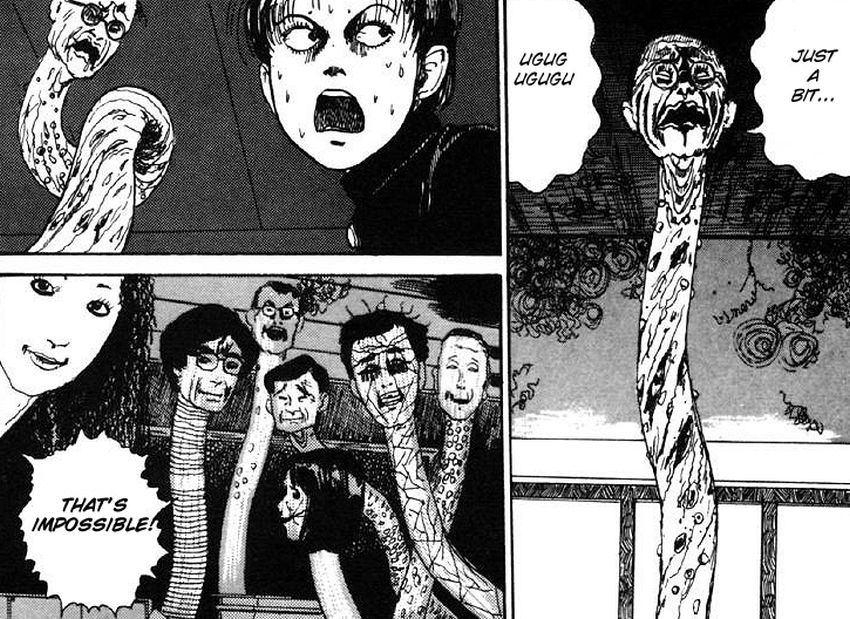
Oshikiri is another of Junji Ito’s recurring characters, with most of his stories revolving around the bizarre events in the sprawling mansion he calls home.
These Junji Ito stories don’t seem to follow a consistent overarching storyline. In fact, given what we learn about the mansion, they might not even be connected at all. Still, they are united by some of Ito’s most striking imagery and body horror.
The first story involves unsettling hallucinations in which people’s necks stretch and twist unnaturally. Another focuses on a mysterious medication that warps the human body into grotesque abominations.
While Oshikiri’s stories are rarely mentioned among Ito’s most famous works, I find them to be among his most creative and haunting. They’re strange, imaginative, and at times deeply disturbing.
Where to read: Collected in Frankenstein.
11. Headless Statues
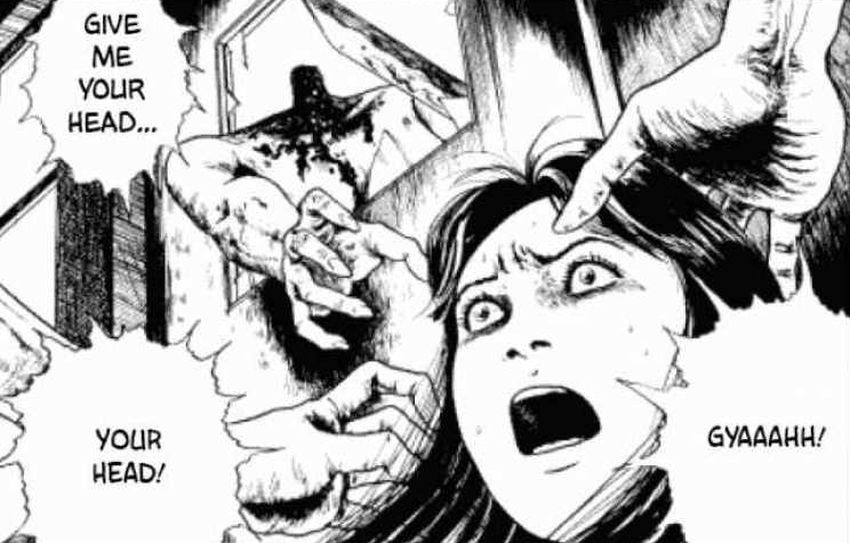
Headless Statues is one of the earliest Junji Ito stories, yet it remains a favorite of mine.
The story follows Rumi, her boyfriend Shimada, and their art teacher Mr. Okabe, a sculptor known for his eerie headless statues. When Mr. Okabe is suddenly murdered, things quickly take a sinister turn. Shimada, the last person seen with him, begins acting strangely, and when the couple returns to the scene of the crime, events spiral into full-blown horror in classic Ito fashion.
From the title alone, you might think you know where this is going, but it’s the execution that makes it memorable. The grotesque, distorted faces, the nightmarish imagery, and the sheer brutality of the visuals make Headless Statues stand out.
It also boasts one of the most chilling final panels in all of Ito’s works.
10. Fashion Model
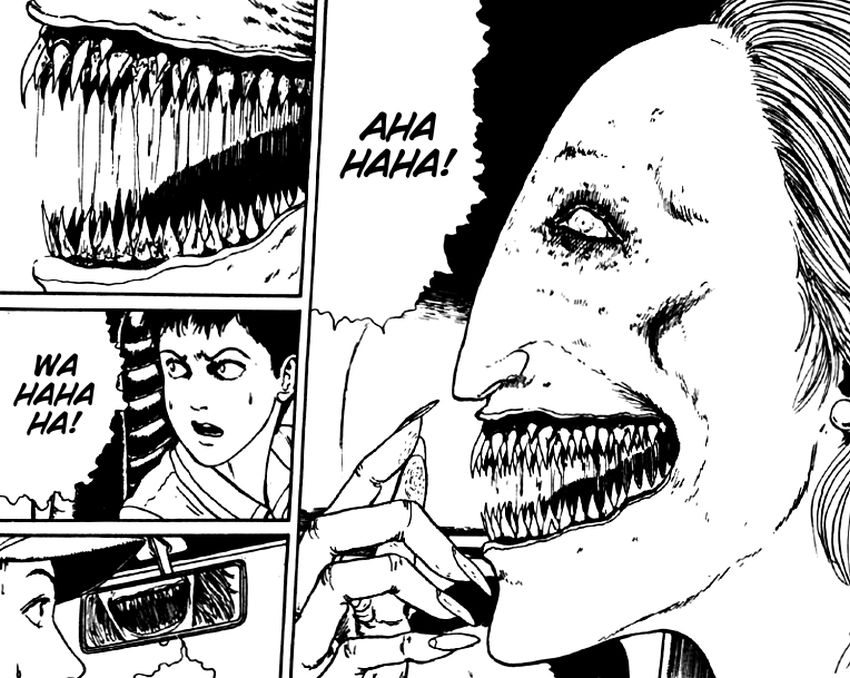
Fashion Model is one of Junji Ito’s most beloved short stories.
We first meet Miss Fuchi through a fashion magazine spread. Her appearance is immediately unsettling: an impossibly long face, sharp, unnatural features, and eyes that don’t seem human. The sight is so disturbing that our protagonist, Iwasaki, begins having nightmares about her.
Eventually, Iwasaki overcomes his fears until his student film crew starts searching for a female lead and recruits Miss Fuchi herself. Seeing her in person only deepens the unease. She’s unnervingly tall, almost towering, and her inhuman proportions hint that something is very wrong.
On the way to the filming location, we get our first real glimpse of the monstrous truth behind Miss Fuchi. From there, things escalate quickly.
While the story is more straightforward than many other Junji Ito stories, with no supernatural powers or cosmic horrors, Fashion Model remains unforgettable. It’s simply a tale of a monster, but what a monster she is. Like Iwasaki, you won’t be able to get Miss Fuchi out of your head.
Where to read: Collected in Shiver.
9. Lovesick Dead
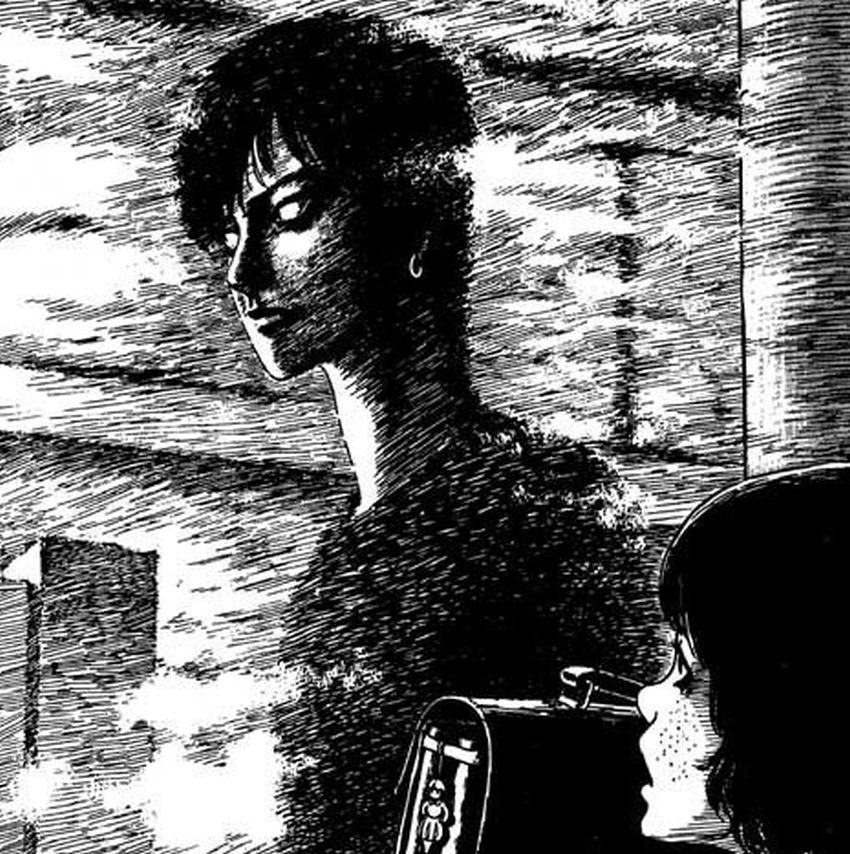
Lovesick Dead was one of the very first Junji Ito stories I ever read, and it’s stuck with me ever since. I’ll admit its place in my personal top ten is as much because of nostalgia as it is for its merits.
One of Ito’s longer works, the story spans five chapters and is set in Nachou-Shi, a town perpetually shrouded in thick, heavy fog, a perfect backdrop for horror.
At its heart is the seemingly harmless practice of intersection fortune-telling: you wait at a crossroads, stop a passerby, and ask them to predict your future. When our protagonist, Ryuusuke, returns to the town after many years away, a mysterious figure appears: the Intersection Pretty Boy. Anyone who encounters him during a fortune-telling will receive only grim prophecies, and soon after will meet a terrible fate.
As with many Ito tales, things spiral into obsession, madness, and grisly death. While some plot threads feel disjointed, the atmosphere and imagery more than make up for it.
The perpetual fog, the sense of isolation, and the strange blend of urban legend and fatalism give Lovesick Dead a unique mood. It’s creepy, mysterious, and laced with memorable visuals, making it a must-read.
Where to read: Collected in Lovesickness.
8. Long Dream
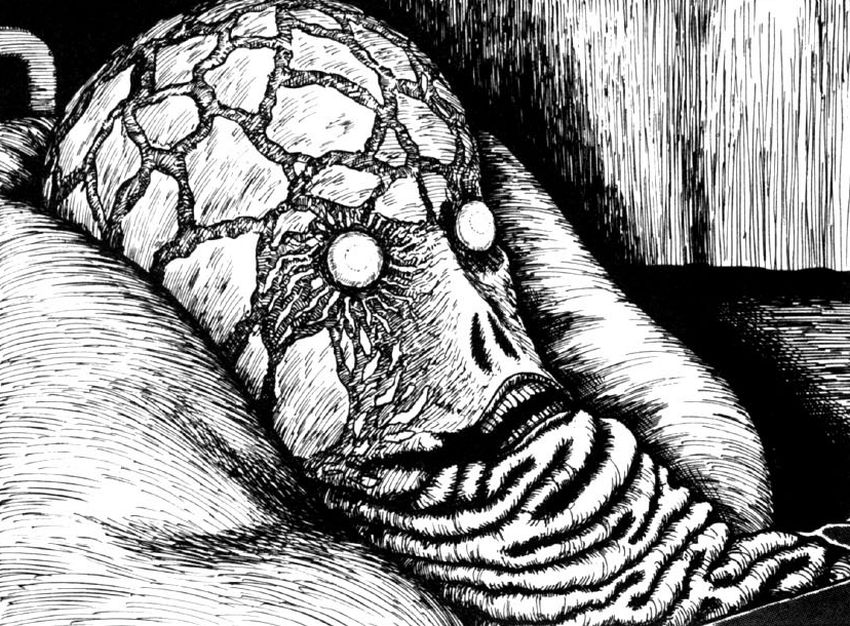
Long Dream is one of Junji Ito’s most fascinating and unique concepts. It’s a horror story that blurs the line between reality and the dream world, but also centers on deeper themes: identity and mortality.
Mami, a young woman with a terminal diagnosis, lives in terrible fear. She claims death visits her hospital room at night. It isn’t death, however, but another patient, Tetsuro Mukoda, who suffers from a bizarre condition: his dreams stretch across impossible spans of time. Days. Weeks. Months. Entire lifespans.
As his dreams grow longer, his grasp on reality slips further and further away. The most chilling idea here isn’t death itself, but the thought of becoming lost in an endless dream. Even worse, forgetting not only the real world, but even your real self.
Ito also layers in a dose of heavy body horror, as those afflicted with the condition slowly transform into something warped, alien, and unrecognizable.
What makes the Long Dream so powerful is its restraint. There are no monsters, no supernatural villains. No, there are only dreams, and the quiet terror of being unable to wake up.
Where to read: Collected in Shiver.
7. Army of One
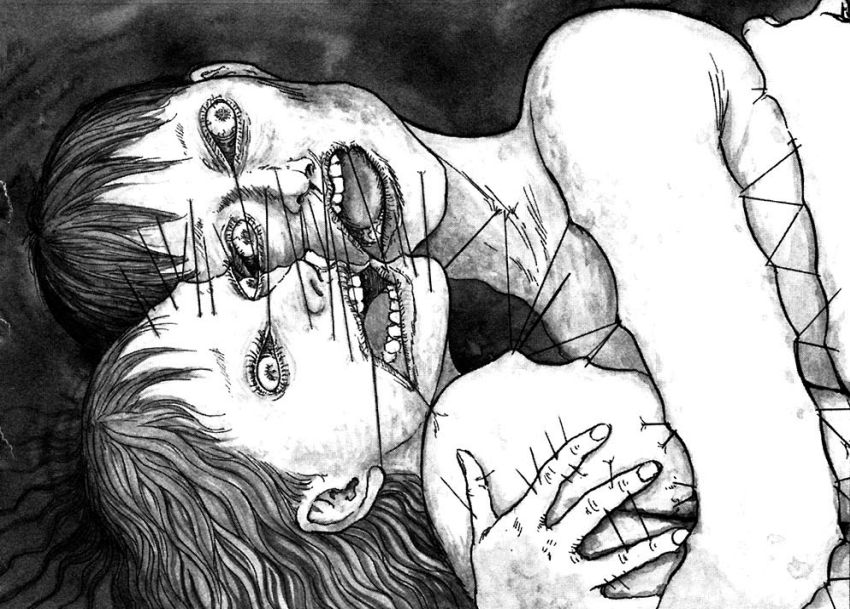
Army of One was originally a bonus chapter included in Hellstar Remina, but at least in my opinion, outshines the main story entirely, and is one of the strongest Junji Ito stories I ever read.
It begins more like a thriller than straight horror. People start disappearing, only to reappear later, their corpses stitched together into grotesque human chains, displayed in public like nightmarish art installations. At first, it’s only pairs of victims. Then, groups of four. Then more. As the numbers rise, one horrifying truth becomes clear: this can’t possibly be the work of a single killer.
Even stranger, there are no defensive wounds, and nothing to suggest the victims fought back before being sewn together.
The brilliance of Army of One, however, lies in how it flips one of horror’s core survival rules on its head. In most horror, strength comes from sticking together. Here, togetherness is a death sentence. The first to die aren’t those alone; it’s those who gather in groups.
It’s a chilling, high-concept idea warped in a tightly paced nightmare, and a reminder of why Ito remains unmatched in turning simple rules into twisted death traps.
Where to read: Collected in Venus in the Blind Spot, retitled Billions Alone.
6. Lingering Farewell
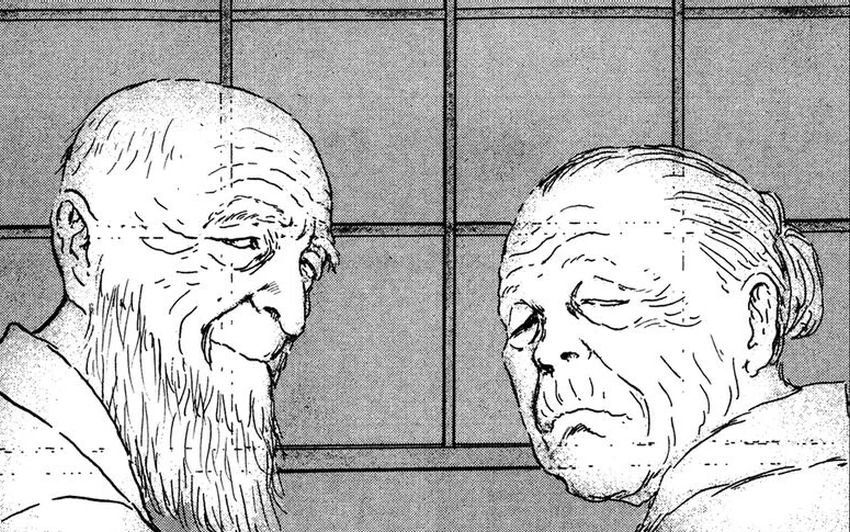
Lingering Farewell is rare among all the Junji Ito stories out there. It’s not terrifying, but quietly melancholic. It trades monsters and grotesquerie for something far more human: grief.
It follows Akiko, a young woman haunted all her life by the fear of losing her father. Years later, after marrying Makoto and joining the Tokura household, she discovers the family’s unusual tradition. When a relative dies, the Tokuras gather to perform a ritual that creates an afterimage of the departed: a faint, lingering presence, as if the person never truly left.
As Akiko learns more about these afterimages and their unsettling nature, the story becomes less about horror and more about the fragility of memory, the way we try to keep the dead with us, and the quiet sorrow of letting go.
It’s a small, bittersweet tale, but it holds a special place in Ito’s work, and is a reminder that his mastery isn’t limited to fear alone, but extends to stories that can haunt the heart as much as the mind.
Where to read: Collected in Fragments of Horror, retitled Gentle Goodbye.
5. The Enigma of Amigara Fault
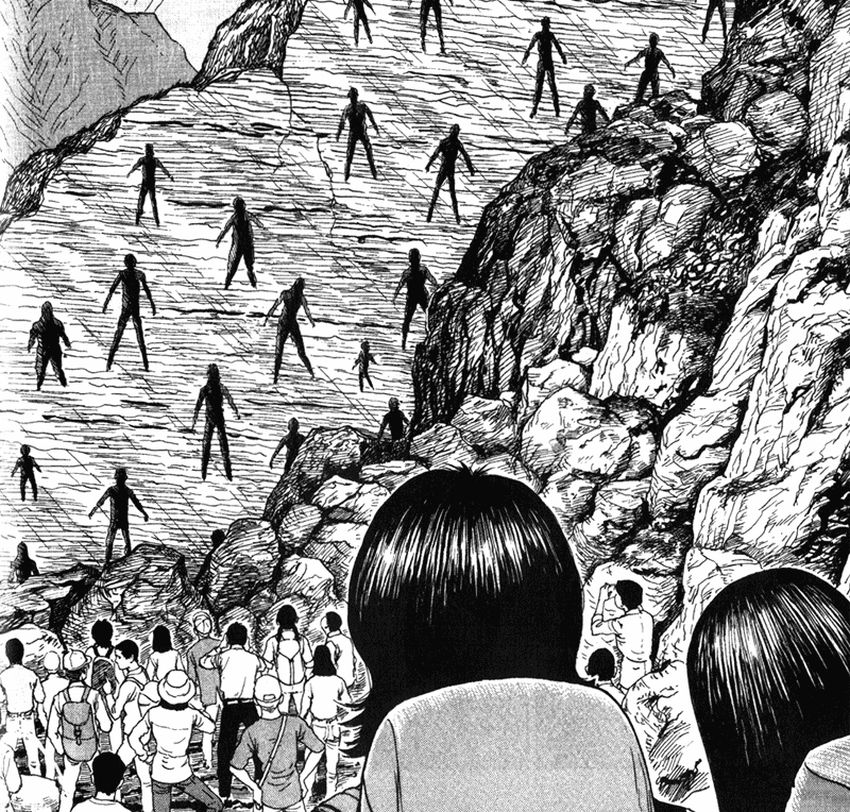
The Enigma of Amigara Fault is one of Junji Ito’s most famous works. It’s a modern classic that has haunted readers ever since it first went viral in the mid-2000s.
After a powerful earthquake, a mountainside splits open, revealing hundreds of unnervingly precise human-shaped holes carved into the rock. News footage of the site spreads across Japan, and something strange happens: people begin to feel an inexplicable pull toward the fault, convinced that their hole is there, waiting for them.
Our main characters, a young man and a woman named Yoshida, are among them. On arrival, they witness others sliding into their perfectly matched holes, disappearing into the darkness without hesitation. The compulsion to enter is overwhelming, even as the sight fills them with dread.
Ito never explains the holes. There’s no origin, no logic, just an impossible phenomenon and the human need to answer it. That mix of claustrophobic terror, existential mystery, and the horror of inevitability makes The Enigma of Amigara Fault so unforgettable.
It’s a masterpiece of pure, lingering unease, and one of the best Junji Ito stories of all time.
Where to read: Collected in Venus in the Blind Spot.
4. Layers of Fear

Layers of Fear is, in my opinion, one of the best Junji Ito stories of all time. It’s built on one of his most bizarre concepts, paired with some of the most jaw-dropping, unsettling imagery of his career.
When I first encountered it, I couldn’t find an English translation and read it in the original Japanese. I didn’t understand a single word, but I couldn’t look away. The visuals alone were enough to make my skin crawl.
It begins with a professor unearthing the grave of a child, which is constructed from layers stacked upon another like geological strata. Years later, the professor’s family is traveling to a memorial ceremony when they’re in a car accident. One daughter, Remi, suffers a terrible injury to her face. At least, that’s what it seems like, but instead of flesh and bone beneath her skin, there’s another layer of skin.
From there, Ito’s imagination spirals outward. The body horror escalates in unpredictable ways, intersecting with the unnerving presence of Remi’s mother, who is still obsessed with preserving her daughter’s childhood.
The genius of Layers of Fear lies in its prolonged horror: the grotesque physical concept, the psychological unease, and the familial obsession. It’s Junji Ito at its peak, and I recommend it to anyone who thinks they’ve already seen his wildest ideas.
3. My Dear Ancestors
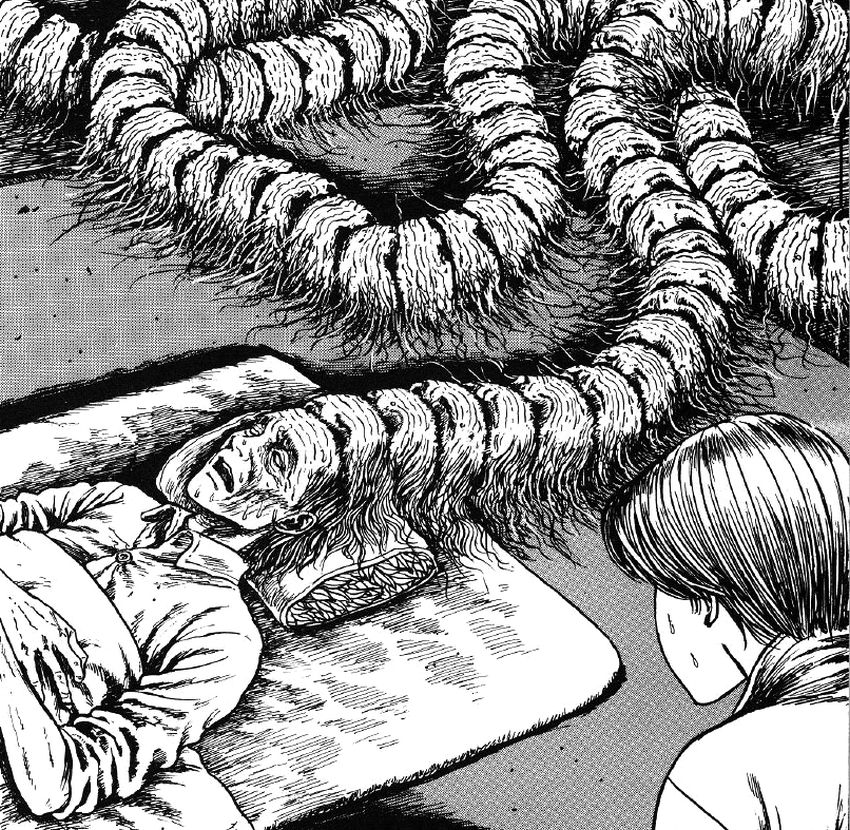
My Dear Ancestors is one of those Junji Ito stories that makes you pause mid-page and wonder what the hell you’re reading.
Risa, a young woman suffering from temporary amnesia, is plagued by recurring nightmares of a massive, caterpillar-like creature. Her boyfriend, Shuichi, tries to help her recover her memories and invites her to his family home to meet his father.
That’s when things take a turn for the surreal. Shuichi’s father enters the room in a strange, crab-like crawl, a movement so unnatural it instantly puts the reader on edge. From there, the truth unravels quickly, revealing the unsettling connection between the father’s grotesque movements and Risa’s missing memories.
My Dear Ancestors is pure Ito: grotesque, bizarre, and unforgettable. It’s one of those Junji Ito stories that leave you equal parts horrified and fascinated, cementing itself as one of the most disturbing entries in his entire catalogue.
Where to read: Collected in Shiver, retitled Honored Ancestors.
2. Uzumaki
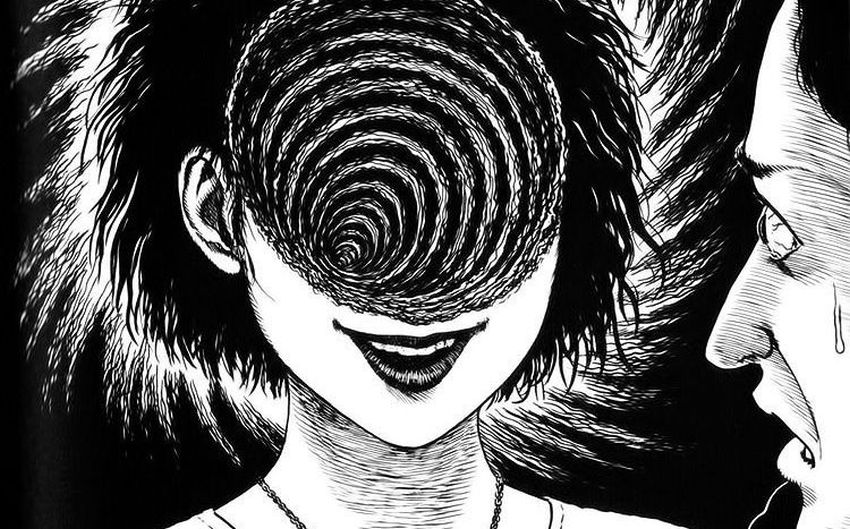
Uzumaki is widely regarded as Junji Ito’s magnum opus.
This surreal, three-volume masterpiece is set in the coastal town of Kurouzu-cho. The story revolves around an inexplicable curse: spirals. They appear in objects, landscapes, weather patterns, and even in the bodies and minds of the townfolk. At first, the phenomenon is strange but harmless, until obsession takes hold, and the spiral begins to warp reality.
From the earliest chapters, Ito delivers some of his most unforgettable imagery. We witness a man twisting his body into a spiral, lovers entwining themselves into a grotesque knot, people slowly transforming into snail-like creatures, and hair writhing with a life of its own. These aren’t isolated. The spiral touches everything, steadily eroding the town in both mind and matter.
The first two volumes are episodic, each chapter a self-contained tale connected by the setting and recurring characters. This structure allows Ito to explore the spiral curse from multiple angles, blending body horror, psychological terror, and the fear of the unknown.
The final volume ties things together in a climactic conclusion, though in my view Ito is at his best when the mystery remains unresolved.
What really makes Uzumaki shine is the spiral itself. It’s not a monster, not a villain, only an abstract force that cannot be reasoned with.
With its clean yet haunting art, Uzumaki showcases Ito at the height of his craft. The precision of his black-and-white art makes the grotesque transformations and impossible shapes even more disturbing.
Reading Uzumaki for the first time is a uniquely unsettling experience, one I highly recommend to any horror fan out there.
Where to read: Tomie (3-in-1 Deluxe Edition).
1. Hanging Balloons
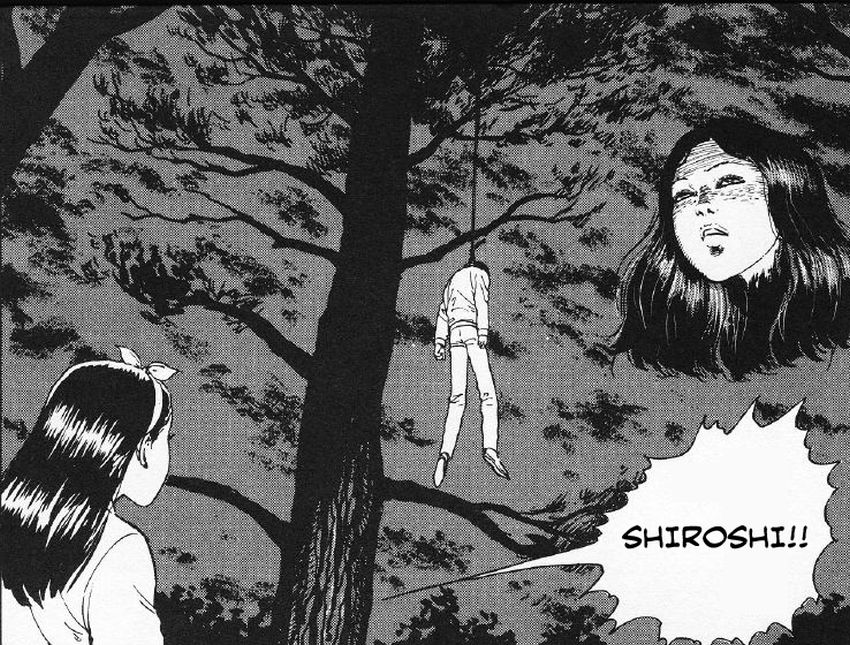
Hanging Balloons is, in my opinion, the best of all Junji Ito stories on this list. It’s a surreal, nightmarish version of an apocalypse unlike anything I’ve seen in horror before.
The story begins with the suicide of Kazuko’s best friend, Terumi, whose body is found hanging outside her apartment. Soon, sightings of Terumi’s ghost spread through town, but it isn’t her full figure, and only a giant floating head. At first dismissed as mass hysteria, the phenomenon becomes undeniable when photographic evidence emerges.
One night, Terumi’s boyfriend, Shiroishi, calls Kazuko, claiming to have been following the ghost. What she witnesses next reveals the truth: massive floating balloons, each bearing the face of a specific person, roam the skies. Each balloon stalks its counterpart relentlessly, attempting to kill them by hanging.
It’s a chilling, absurd premise that grows more horrifying the longer you think about it. There are no monsters or zombies here, only the grotesque image of your own face hunting you down.
Ito masterfully paces the story, starting with the atmosphere of a ghost tale before shifting into full-blown apocalyptic horror. The mystery is never explained: we don’t know where the balloons came from, why they exist, or how they choose their victims. These unanswered questions only make the story more unsettling.
And then there’s the unforgettable final panel, a single image that cements Hanging Balloons as a masterpiece of bizarre horror.
With its slow build-up, disturbing visuals, and surreal concepts, Hanging Balloons is one of the most uniquely terrifying apocalyptic scenarios in fiction.
Where to read: Collected in Shiver, retitled Hanging Blimp.

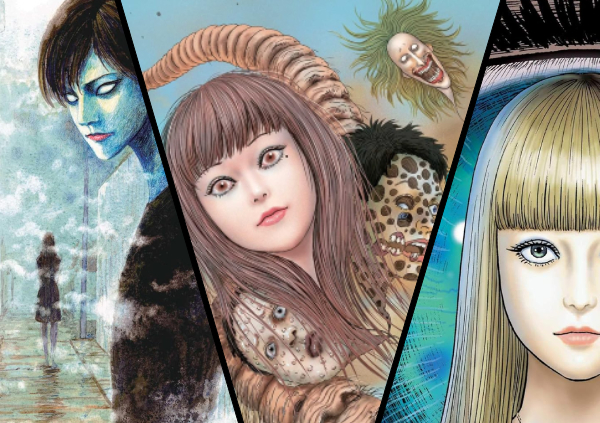
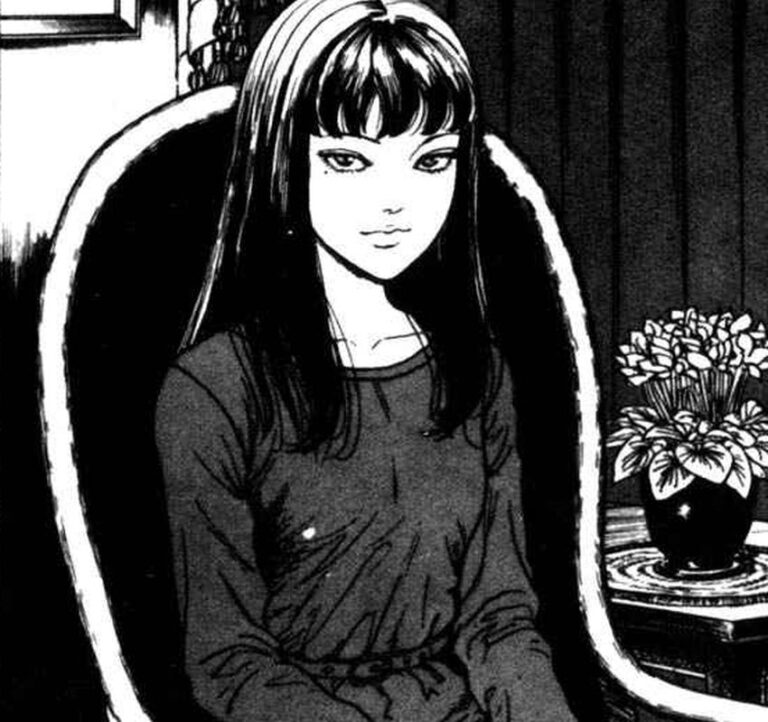






I love Junji Ito’s work! They are so unique and terrifying to me and I love it! I would love to know if there are any female horror manga writers/artists out there. (I’m sure there are but I sadly don’t hear about them as much)
Unfortunately I don’t know about many myself. The only one I can think of is Kaori Yuki who created the series Count Cain or Godchild which is a gothic manga. I only read part of it, but I thought it was quite interesting at times, definitely worth checking it out!
Although, one more thing that I must admit is that even though I greatly admire Ito and love his work, some of this stuff focus on certain misogynistic stereotypes that are not that appreciated. Like in some stories where the female character is sadly the only girl in her friend group and anytime another female character appears, she immediately becomes jealous of her, which I really hate to see. I’m definitely thinking of ones like the Seashore story from Mimi’s Ghost Stories, among a few others of his. I just wish he wouldn’t depict female characters in those ways.
I can see your point about female characters. I’m not sure if it’s Ito’s intention though. He always overdraws emotions and obsessions like jealousy. I feel he isn’t trying to depict real characters, but specifically those who are easily jealous, easily fall in love or easily grow obsessed with certain things. Again though, I can see your point.
I love Junji Ito! It’s a shame how critically you approach some stories. I don’t force myself to look for flaws in things I love. My top Junji Ito is 1 Uzumaki 2 Hellstar Remina 3 Tomie. Army of one is for sure in my top 10, but I think Remina is better because its epicness perfectly balances with the mystery of the planet that has not been explained. And some silly moments are balanced with a lot of scary ones. I think that both Remina and Army of one have really brilliant endings that give you goosebumps